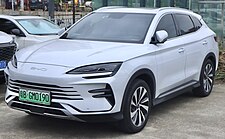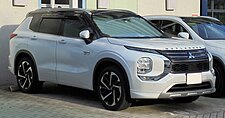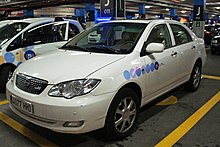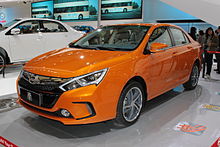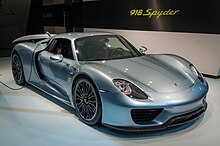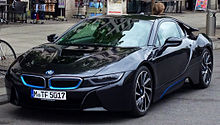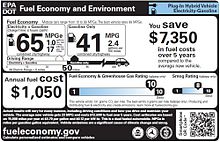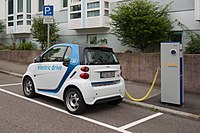Plug-in hybrid
This article needs to be updated. (December 2023) |
| Part of a series on |
| Sustainable energy |
|---|
 |
A plug-in hybrid electric vehicle (PHEV) or simply plug-in hybrid is a type of hybrid electric vehicle equipped with a rechargeable battery pack that can be directly replenished via a charging cable plugged into an external electric power source, in addition to charging internally by its on-board internal combustion engine-powered generator. While PHEVs are predominantly passenger cars, there are also plug-in hybrid variants of sports cars, commercial vehicles, vans, utility trucks, buses, trains, motorcycles, mopeds, military vehicles and boats.[7]
Similar to battery electric vehicles (BEVs), plug-in hybrids can use centralized generators of renewable energy (e.g. solar, wind or hydroelectric) to be largely emission-free, or a fossil plant in which case they displace greenhouse gas emissions from the car tailpipe exhaust to the power station. As opposed to conventional hybrid electric vehicles (HEVs), PHEVs generally have a larger battery pack that can be recharged (theoretically) from anywhere with access to the electrical grid, offering enhanced energy efficiency and cost-effectiveness when compared to relying solely on the on-board generator. Additionally, PHEVs can support longer and more frequent all-electric range driving, and their electric motors often have higher power output and torque, are more responsive in acceleration, and overall have lower operating costs. Although a PHEV's battery pack is smaller than that of all-electric vehicles of the same weight, as it must accommodate its combustion engine and hybrid drivetrain, it provides the added flexibility of reverting to the use of its gasoline/diesel engine, akin to a conventional HEV if the battery charge is depleted. This feature helps alleviate range anxiety, particularly in areas lacking sufficient charging infrastructure.
Mass-produced PHEVs have been available to the public in China and the United States since 2010,[8][9][10] with the introduction of the Chevrolet Volt, which was the best selling PHEV until it was surpassed by the Mitsubishi Outlander PHEV at the Volt's end of production in 2019.[11] By 2021, BYD Auto emerged as the largest plug-in hybrid vehicle manufacturer in the world. As of May 2024[update], BYD plug-in hybrid cumulative sales surpassed 3.6 million units.[12] The BYD Song DM line of SUVs contributed over 1.05 million units.[13][14][2][15]
As of December 2019[update], the global stock of PHEVs totalled 2.4 million units, representing one-third of the stock of plug-in electric passenger cars on the world's roads.[16] As of December 2019[update], China had the world's largest stock of PHEVs with 767,900 units, followed by the United States with 567,740, and the United Kingdom with 159,910.[16]
Terminology
[edit]A plug-in hybrid's all-electric range is designated by PHEV-[miles] or PHEV[kilometers]km in which the number represents the distance the vehicle can travel on battery power alone. For example, a PHEV-20 can travel 32 km (20 miles) without using its combustion engine, so it may also be designated as a PHEV32km.[17]
For these cars to be battery operated, they go through charging processes that use different currents. These currents are known as Alternating Current (AC) used for on board chargers and Direct Current (DC) used for external charging.[18]
Other popular terms sometimes used for plug-in hybrids are "grid-connected hybrids", "Gas-Optional Hybrid Electric Vehicle" (GO-HEV) or simply "gas-optional hybrids".[19][20][21] GM calls its Chevrolet Volt series plug-in hybrid an "Extended-Range Electric Vehicle".[22][23]
History
[edit]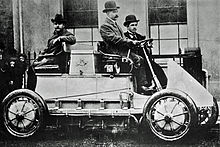
Invention and early interest
[edit]The Lohner–Porsche Mixte Hybrid, produced as early as 1899, was the first hybrid electric car.[24][25] Early hybrids could be charged from an external source before operation. The term "plug-in hybrid" has come to mean a hybrid vehicle that can be charged from a standard electrical wall socket. The term "plug-in hybrid electric vehicle" was coined by UC Davis Professor Andrew Frank,[26] who has been called the "father of the modern plug-in hybrid".[27][28][29]
The July 1969 issue of Popular Science featured an article on the General Motors XP-883 plug-in hybrid. The concept commuter vehicle housed six 12-volt lead–acid batteries in the trunk area and a transverse-mounted DC electric motor turning a front-wheel drive. The car could be plugged into a standard North American 120 volt AC outlet for recharging.[30]
Revival of interest
[edit]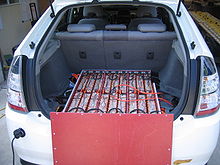
In 2003, Renault began selling the Elect'road, a plug-in series hybrid version of their popular Kangoo, in Europe. In addition to its engine, it could be plugged into a standard outlet and recharged to 95% range in about 4 hours.[31] After selling about 500 vehicles, primarily in France, Norway and the UK, the Elect'road was redesigned in 2007.[32]
With the availability of hybrid vehicles and the rising gas prices in the United States starting around 2002, interest in plug-in hybrids increased.[33] Some plug-in hybrids were conversions of existing hybrids; for example, the 2004 CalCars conversion of a Prius to add lead acid batteries and a range of up to 15 km (9 mi) using only electric power.[34]
In 2006, both Toyota and General Motors announced plans for plug-in hybrids.[35][36] GM's Saturn Vue project was cancelled, but the Toyota plug-in was certified for road use in Japan in 2007.[37]
In 2007, Quantum Technologies and Fisker Coachbuild, LLC announced the launch of a joint venture in Fisker Automotive.[38] Fisker intended to build a US$80,000 luxury PHEV-50, the Fisker Karma, initially scheduled for late 2009.[39]
In 2007, Aptera Motors announced their Typ-1 two seater. That company folded in December 2011.[40]
In 2007, Chinese car manufacturer BYD Auto, owned by China's largest mobile phone battery maker, announced it would be introducing a production PHEV-60 sedan in China in the second half of 2008. BYD exhibited it in January 2008 at the North American International Auto Show in Detroit. Based on BYD's midsize F6 sedan, it uses lithium iron phosphate (LiFePO4)-based batteries instead of lithium-ion, and can be recharged to 70% of capacity in 10 minutes.[41]

In 2007 Ford delivered the first Ford Escape Plug-in Hybrid of a fleet of 20 demonstration PHEVs to Southern California Edison.[42] As part of this demonstration program Ford also developed the first flexible-fuel plug-in hybrid SUV, which was delivered in June 2008.[43] This demonstration fleet of plug-ins has been in field testing with utility company fleets in the U.S. and Canada,[44] and during the first two years since the program began, the fleet has logged more than 75,000 miles.[45] In August 2009 Ford delivered the first Escape Plug-in equipped with intelligent vehicle-to-grid (V2G) communications and control system technology, and Ford plans to equip all 21 plug-in hybrid Escapes with the vehicle-to-grid communications technology.[45] Sales of the Escape PHEV were scheduled for 2012.[44]
On January 14, 2008, Toyota announced they would start sales of lithium-ion battery PHEVs by 2010,[46][47] but later in the year Toyota indicated they would be offered to commercial fleets in 2009.[48]
On March 27, the California Air Resources Board (CARB) modified their regulations, requiring automobile manufacturers to produce 58,000 plug-in hybrids during 2012 through 2014.[49] This requirement is an asked-for alternative to an earlier mandate to produce 25,000 pure zero-emissions vehicles, reducing that requirement to 5,000.[50] On June 26, Volkswagen announced that they would be introducing production plug-ins based on the Golf compact. Volkswagen uses the term 'TwinDrive' to denote a PHEV.[51] In September, Mazda was reported to be planning PHEVs.[52] On September 23, Chrysler announced that they had prototyped a plug-in Jeep Wrangler and a Chrysler Town and Country mini-van, both PHEV-40s with series powertrains, and an all-electric Dodge sports car, and said that one of the three vehicles would go into production.[53][54]
On October 3, the U.S. enacted the Energy Improvement and Extension Act of 2008. The legislation provided tax credits for the purchase of plug-in electric vehicles of battery capacity over 4 kilowatt-hours.[55][56] The federal tax credits were extended and modified by the American Clean Energy and Security Act of 2009, but now the battery capacity must be over 5 kWh and the credit phases out after the automaker has sold at least 200,000 vehicles in the U.S.[57]
Series production
[edit]On December 15, 2008, BYD Auto began selling its F3DM in China, becoming the first production plug-in hybrid sold in the world, though initially was available only for corporate and government customers.[60][61][62] Sales to the general public began in Shenzhen in March 2010,[8][9] but because the F3DM nearly doubles the price of cars that run on conventional fuel, BYD expects subsidies from the local government to make the plug-in affordable to personal buyers.[8] Toyota tested 600 pre-production Prius Plug-ins in Europe and North America in 2009 and 2010.[63][64]
Volvo Cars built two demonstration versions of Volvo V70 Plug-in Hybrids in 2009 but did not proceed with production. The V60 plug-in hybrid was released in 2011 and was available for sale.
In October 2010 Lotus Engineering unveiled the Lotus CityCar, a plug-in series hybrid concept car designed for flex-fuel operation on ethanol, or methanol as well as regular gasoline.[65][66] The lithium battery pack provides an all-electric range of 60 kilometres (37 mi), and the 1.2-liter flex-fuel engine kicks in to allow to extend the range to more than 500 kilometres (310 mi).[65][66]
GM officially launched the Chevrolet Volt in the U.S. on November 30, 2010, and retail deliveries began in December 2010.[10] Its sibling the Opel/Vauxhall Ampera was launched in Europe between late 2011 and early 2012. The first deliveries of the Fisker Karma took place in July 2011,[67] and deliveries to retail customers began in November 2011. The Toyota Prius Plug-in Hybrid was released in Japan in January 2012,[68] followed by the United States in February 2012.[69] Deliveries of the Prius PHV in Europe began in late June 2012.[70] The Ford C-Max Energi was released in the U.S. in October 2012,[71] the Volvo V60 Plug-in Hybrid in Sweden by late 2012.[72]
The Honda Accord Plug-in Hybrid was released in selected U.S. markets in January 2013,[73] and the Mitsubishi Outlander P-HEV in Japan in January 2013, becoming the first SUV plug-in hybrid in the market.[74] Deliveries of the Ford Fusion Energi began in February 2013.[75][76] BYD Auto stopped production of its BYD F3DM due to low sales,[77] and its successor, the BYD Qin, began sales in Costa Rica in November 2013, with sales in other countries in Latin America scheduled to begin in 2014.[78][79][80] Qin deliveries began in China in mid December 2013.[59]

Deliveries to retail customers of the limited edition McLaren P1 supercar began in the UK in October 2013,[81] and the Porsche Panamera S E-Hybrid began deliveries in the U.S. in November 2013. The first retail deliveries of the Cadillac ELR took place in the U.S. in December 2013.[82] The BMW i8 and the limited edition Volkswagen XL1 were released to retail customers in Germany in June 2014.[83][84] The Porsche 918 Spyder was also released in Europe and the U.S. in 2014. The first units of the Audi A3 Sportback e-tron and Volkswagen Golf GTE were registered in Germany in August 2014.[85]
In December 2014 BMW announced the group is planning to offer plug-in hybrid versions of all its core-brand models using eDrive technology developed for its BMW i brand plug-in vehicles (BMW i3 and BMW i8). The goal of the company is to use plug-in technology to continue offering high performance vehicles while reducing CO2 emissions below 100g/km. At the time of the announcement the carmaker was already testing a BMW 3 Series plug-in hybrid prototype.[86] The first model available for retail sales will be the 2016 BMW X5 eDrive, with the production version unveiled at the 2015 Shanghai Motor Show.[87] The second generation Chevrolet Volt was unveiled at the January 2015 North American International Auto Show,[88] and retail deliveries began in the U.S. and Canada in October 2015.[89][90]
In March 2015 Audi said they planned on making a plug-in hybrid version of every model series, and that they expect plug-in hybrids, together with natural gas vehicles and battery-electric drive systems, to have a key contribution in achieving the company's CO2 targets. The Audi Q7 e-tron will follow the A3 e-tron already in the market.[91] Also in March 2015, Mercedes-Benz announced that the company's main emphasis regarding alternative drives in the next years will be on plug-in hybrids. The carmaker plans to introduce 10 new plug-in hybrid models by 2017, and its next release was the Mercedes-Benz C 350 e, Mercedes' second plug-in hybrid after the S 500 Plug-In Hybrid.[92] Other plug-in hybrid released in 2015 are the BYD Tang, Volkswagen Passat GTE, Volvo XC90 T8, and the Hyundai Sonata PHEV.
Global combined Volt/Ampera family sales passed the 100,000 unit milestone in October 2015.[93] By the end of 2015, over 517,000 highway legal plug-in hybrid electric cars have been sold worldwide since December 2008 out of total global sales of more than 1.25 million light-duty plug-in electric cars.[94][95]
In February 2016, BMW announced the introduction of the "iPerformance" model designation, which will be given to all BMW plug-in hybrid vehicles from July 2016. The aim is to provide a visible indicator of the transfer of technology from BMW i to the BMW core brand. The new designation will be used first on the plug-in hybrid variants of the new BMW 7 Series, the BMW 740e iPerformance,[96] and the 3 Series, the BMW 330e iPerformance.[97]
Hyundai Motor Company made the official debut of its three model Hyundai Ioniq line-up at the 2016 Geneva Motor Show.[98] The Ioniq family of electric drive vehicles includes the Ioniq Plug-in, which is expected to achieve a fuel economy of 125 mpg‑e (27 kW⋅h/100 mi; 16.8 kW⋅h/100 km) in all-electric mode.[99] The Ioniq Plug-in is scheduled to be released in the U.S. in the fourth quarter of 2017.[100]
The second generation Prius plug-in hybrid, called Prius Prime in the U.S. and Prius PHV in Japan,[101] was unveiled at the 2016 New York International Auto Show. Retail deliveries of the Prius Prime began in the U.S. in November 2016,[102] and is scheduled to be released Japan by the end of 2016.[101][103] The Prime has an EPA-rated all-electric range of 25 mi (40 km), over twice the range of the first generation model, and an EPA rated fuel economy of 133 mpg‑e (25.3 kW⋅h/100 mi) in all-electric mode (EV mode), the highest MPGe rating in EV mode of any vehicle rated by EPA.[104][105] Unlike its predecessor, the Prime runs entirely on electricity in EV mode.[106] Global sales of the Mitsubishi Outlander PHEV passed the 100,000 unit milestone in March 2016.[107][108] BYD Qin sales in China reached the 50,000 unit milestone in April 2016, becoming the fourth plug-in hybrid to pass that mark.[109]
In June 2016, Nissan announced it will introduce a compact range extender car in Japan before March 2017. The series plug-in hybrid will use a new hybrid system, dubbed e-Power, which debuted with the Nissan Gripz concept crossover showcased at the 2015 Frankfurt Auto Show.[110]
In January 2016, Chrysler debuted its plug-in hybrid minivan, the Chrysler Pacifica Hybrid, with an EPA rated electric-only range of 48 km (30 miles).[111] This was the first hybrid minivan of any type. It was first sold in the United States, Canada, and Mexico in 2017.
In December 2017, Honda began retail deliveries of the Honda Clarity Plug-In Hybrid in the United States and Canada, with an EPA rated electric-only range of 76 km (47 miles).[112]
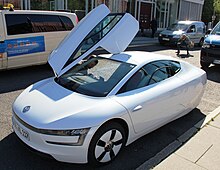
In 2013, Volkswagen started production on the Volkswagen XL1, a two-person limited production diesel-powered plug-in hybrid vehicle designed to be able to travel 100 km/L (280 mpg‑imp; 235 mpg‑US) on diesel, while still being both roadworthy and practical. The model is built with a 800 cc (49 cu in) TDI twin-cylinder, common-rail 35 kW (47 hp) turbo-diesel and a 20 kW (27 hp) electric motor. The model is unique in that it is one of the only mass produced plug-in diesel hybrid vehicles and one of the only mass produced diesel hybrid vehicles in general.[113][114][115]
Technology
[edit]Powertrains
[edit]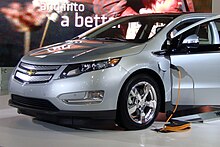
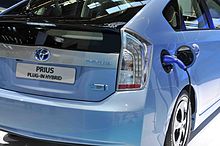
PHEVs are based on the same three basic powertrain architectures of conventional hybrids; a series hybrid is propelled by electric motors only, a parallel hybrid is propelled both by its internal combustion engine and by electric motors operating concurrently, and a series-parallel hybrid operates in either mode. While a plain hybrid vehicle charges its battery from its engine only, a plug-in hybrid can obtain a significant amount of the energy required to recharge its battery from external sources.[citation needed]
Dual plug-in hybrids
[edit]These contain two different energy recovery systems.
The Mercedes-AMG ONE is a plug-in dual hybrid.
The Mercedes-Benz C-Class (W206) and the Mercedes C254/X254 also have an electrically assisted turbocharger/MGU-H.[116][117]
Charging systems
[edit]The battery charger can be on-board or external to the vehicle. The process for an on-board charger is best explained as AC power being converted into DC power, resulting in the battery being charged.[18] On-board chargers are limited in capacity by their weight and size, and by the limited capacity of general-purpose AC outlets. Dedicated off-board chargers can be as large and powerful as the user can afford, but require returning to the charger; high-speed chargers may be shared by multiple vehicles.
Using the electric motor's inverter allows the motor windings to act as the transformer coils, and the existing high-power inverter as the AC-to-DC charger. As these components are already required on the car, and are designed to handle any practical power capability, they can be used to create a very powerful form of on-board charger with no significant additional weight or size. AC Propulsion uses this charging method, referred to as "reductive charging".[118]
Modes of operation
[edit]A plug-in hybrid operates in charge-depleting and charge-sustaining modes. Combinations of these two modes are termed blended mode or mixed-mode. These vehicles can be designed to drive for an extended range in all-electric mode, either at low speeds only or at all speeds. These modes manage the vehicle's battery discharge strategy, and their use has a direct effect on the size and type of battery required:[119]
Charge-depleting mode allows a fully charged PHEV to operate exclusively (or depending on the vehicle, almost exclusively, except during hard acceleration) on electric power until its battery state of charge is depleted to a predetermined level, at which time the vehicle's internal combustion engine or fuel cell will be engaged. This period is the vehicle's all-electric range. This is the only mode that a battery electric vehicle can operate in, hence their limited range.[120]
Mixed mode describes a trip using a combination of multiple modes. For example, a car may begin a trip in low speed charge-depleting mode, then enter onto a freeway and operate in blended mode. The driver might exit the freeway and drive without the internal combustion engine until all-electric range is exhausted. The vehicle can revert to a charge sustaining-mode until the final destination is reached. This contrasts with a charge-depleting trip that would be driven within the limits of a PHEV's all-electric range.
Most PHEV's also have two additional charge sustaining modes:
Battery Hold; the electric motor is locked out and the vehicle operates exclusively on combustion power, so that whatever charge is left in the battery remains for when mixed mode or full electric operation are re-engaged, whilst regenerative braking will still be available to boost the battery charge. On some PHEVs, vehicle services that use the traction battery (such as heating and air conditioning) are placed in a low power consumption mode to further conserve the remaining battery charge. The lock-out of the electric motor is automatically overridden (charge permitting) should full acceleration be required.
Self Charge; the electric motor's armature is engaged to the transmission, but is connected to the battery so that it runs as a generator and therefore recharges the battery whilst the car is in motion, although this comes at the expense of higher fuel consumption, as the combustion engine has to both power the vehicle itself and charge the battery. This is useful for 'charging on the move' when there are limited places to plug the vehicle in.
Electric power storage
[edit]The optimum battery size varies depending on whether the aim is to reduce fuel consumption, running costs, or emissions, but a 2009 study[121] concluded that "The best choice of PHEV battery capacity depends critically on the distance that the vehicle will be driven between charges. Our results suggest that for urban driving conditions and frequent charges every 10 miles or less, a low-capacity PHEV sized with an AER (all-electric range) of about 7 miles would be a robust choice for minimizing gasoline consumption, cost, and greenhouse gas emissions. For less frequent charging, every 20–100 miles, PHEVs release fewer GHGs, but HEVs are more cost effective."
PHEVs typically require deeper battery charging and discharging cycles than conventional hybrids. Because the number of full cycles influences battery life, this may be less than in traditional HEVs, which do not deplete their batteries as fully. Nonetheless, some authors argue that PHEVs will soon become standard in the automobile industry.[122] Design issues and trade-offs against battery life, capacity, heat dissipation, weight, costs, and safety need to be solved.[123] Advanced battery technology is under development, promising greater energy densities by both mass and volume,[124] and battery life expectancy is expected to increase.[125]
The cathodes of some early 2007 lithium-ion batteries are made from lithium-cobalt metal oxide. This material is expensive, and cells made with it can release oxygen if overcharged. If the cobalt is replaced with iron phosphates, the cells will not burn or release oxygen under any charge. At early 2007 gasoline and electricity prices, the break-even point is reached after six to ten years of operation. The payback period may be longer for plug-in hybrids, because of their larger, more expensive batteries.[126]
Nickel–metal hydride and lithium-ion batteries can be recycled; Toyota, for example, has a recycling program in place under which dealers are paid a US$200 credit for each battery returned.[127] Plug-in hybrids typically use larger battery packs than comparable conventional hybrids, however, and thus require more resources. Pacific Gas and Electric Company (PG&E) has suggested that utilities could purchase used batteries for backup and load leveling purposes. They state that while these used batteries may be no longer usable in vehicles, their residual capacity still has significant value.[128] More recently, General Motors (GM) has said it has been "approached by utilities interested in using recycled Volt batteries as a power storage system, a secondary market that could bring down the cost of the Volt and other plug-in vehicles for consumers".[129]
Ultracapacitors (or "supercapacitors") are used in some plug-in hybrids, such as AFS Trinity's concept prototype, to store rapidly available energy with their high power density, in order to keep batteries within safe resistive heating limits and extend battery life.[130][131] The CSIRO's UltraBattery combines a supercapacitor and a lead acid battery in a single unit, creating a hybrid car battery that lasts longer, costs less and is more powerful than current technologies used in plug-in hybrid electric vehicles (PHEVs).[132]
Conversions of production vehicles
[edit]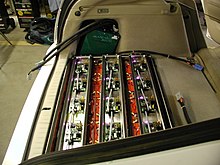
There are several companies that are converting fossil fuel non-hybrid vehicles to plug-in hybrids:[133][134]
Aftermarket conversion of an existing production hybrid to a plug-in hybrid[135] typically involves increasing the capacity of the vehicle's battery pack and adding an on-board AC-to-DC charger. Ideally, the vehicle's powertrain software would be reprogrammed to make full use of the battery pack's additional energy storage capacity and power output.
Many early plug-in hybrid electric vehicle conversions have been based on the Toyota Prius.[136] Some of the systems have involved replacement of the vehicle's original NiMH battery pack and its electronic control unit. Others add an additional battery back onto the original battery pack.[137]
Target market
[edit]In recent years, demand for all- electric vehicles, especially in the United States market, has been driven by government incentives through subsidies, lobbyists, and taxes.[138] In particular, American sales of the Nissan Leaf have depended on generous incentives and special treatment in the state of Georgia, the top selling Leaf market.[139] According to international market research, 60% of respondents believe a battery driving range of less than 160 km (99 mi) is unacceptable even though only 2% drive more than that distance per day.[140] Among popular current all-electric vehicles, only the Tesla (with the most expensive version of the Model S offering a 265 miles (426 km) range in the U.S. Environmental Protection Agency 5-cycle test) significantly exceeds this threshold. In 2021, for the 2022 model year, the Nissan Leaf has an EPA rated range of 212 miles (341 km) for the 60 kWh model.
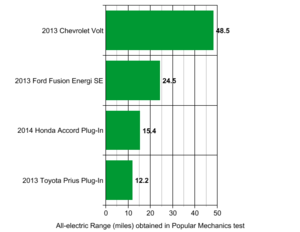
Plug-in hybrids provide the extended range and potential for refueling of conventional hybrids while enabling drivers to use battery electric power for at least a significant part of their typical daily driving. The average trip to or from work in the United States in 2009 was 11.8 miles (19.0 km),[141] while the average distance commuted to work in England and Wales in 2011 was slightly lower at 9.3 miles (15 km).[142] Since building a PHEV with a longer all-electric range adds weight and cost, and reduces cargo and/or passenger space, there is not a specific all-electric range that is optimal. The accompanying graph shows the observed all-electric range, in miles, for four popular U.S. market plug-in hybrids, as tested by Popular Mechanics magazine.[143]
A key design parameter of the Chevrolet Volt was a target of 40 miles (64 km) for the all-electric range, selected to keep the battery size small and lower costs, and mainly because research showed that 78% of daily commuters in the U.S. travel 40 mi (64 km) or less. This target range would allow most travel to be accomplished electrically driven and the assumption was made that charging will take place at home overnight. This requirement translated using a lithium-ion battery pack with an energy storage capacity of 16 kWh considering that the battery would be used until the state of charge (SOC) of the battery reached 30%.[144][145]
In October 2014 General Motors reported, based on data collected through its OnStar telematics system since Volt deliveries began, and with over 1 billion miles (1.6 billion km) traveled, that Volt owners drive about 62.5% of their trips in all-electric mode.[146] In May 2016, Ford reported, based on data collected from more than 610 million miles (976 million km) logged by its electrified vehicles through its telematics system, that drivers of these vehicles run an average of 13,500 mi (21,700 km) annually on their vehicles, with about half of those miles operating in all-electric mode. A breakdown of these figures show an average daily commute of 42 mi (68 km) for Ford Energi plug-in hybrid drivers. Ford notes that with the enhanced electric range of the 2017 model year model, the average Fusion Energi commuter could go the entire day using no gasoline, if the car is fully charged both, before leaving for work and before leaving for home. According to Ford data, currently most customers are likely charging their vehicles only at home.[147]
The 2015 edition of the EPA's annual report "Light-Duty Automotive Technology, Carbon Dioxide Emissions, and Fuel Economy Trends" estimates the following utility factors for 2015 model year plug-in hybrids to represent the percentage of miles that will be driven using electricity by an average driver, whether in electric only or blended modes: 83% for the BMW i3 REx, 66% for the Chevrolet Volt, 45% for the Ford Energi models, 43% for the McLaren P1, 37% for the BMW i8, and 29% for the Toyota Prius PHV.[148] A 2014 analysis conducted by the Idaho National Laboratory using a sample of 21,600 all-electric cars and plug-in hybrids, found that Volt owners traveled on average 9,112 miles in all-electric mode (e-miles) per year, while Leaf owners traveled 9,697 e-miles per year, despite the Volt's shorter all-electric range, about half of the Leaf's.[149]
Comparison to non-plug-in hybrids
[edit]Fuel efficiency and petroleum displacement
[edit]Plug-in hybrids have the potential to be even more efficient than conventional hybrids because a more limited use of the PHEV's internal combustion engine may allow the engine to be used at closer to its maximum efficiency. While a Toyota Prius is likely to convert fuel to motive energy on average at about 30% efficiency (well below the engine's 38% peak efficiency), the engine of a PHEV-70 would be likely to operate far more often near its peak efficiency because the batteries can serve the modest power needs at times when the combustion engine would be forced to run well below its peak efficiency.[120] The actual efficiency achieved depends on losses from electricity generation, inversion, battery charging/discharging, the motor controller and motor itself, the way a vehicle is used (its duty cycle), and the opportunities to recharge by connecting to the electrical grid.
Each kilowatt hour of battery capacity in use will displace up to 50 U.S. gallons (190 L; 42 imp gal) of petroleum fuels per year (gasoline or diesel).[150] Also, electricity is multi-sourced and, as a result, it gives the greatest degree of energy resilience.[151]
The actual fuel economy for PHEVs depends on their powertrain's operating modes, the all-electric range, and the amount of driving between charges. If no gasoline is used the miles per gallon gasoline equivalent (MPG-e) depends only on the efficiency of the electric system. The first mass production PHEV available in the U.S. market, the 2011 Chevrolet Volt, with an EPA rated all-electric range of 35 mi (56 km) and an additional gasoline-only extended range of 344 mi (554 km), has an EPA combined city/highway fuel economy of 93 MPG-e in all-electric mode, and 37 mpg‑US (6.4 L/100 km; 44 mpg‑imp) in gasoline-only mode, for an overall combined gas-electric fuel economy rating of 60 mpg‑US (3.9 L/100 km; 72 mpg‑imp) equivalent (MPG-e).[152][153] The EPA also included in the Volt's fuel economy label a table showing fuel economy and electricity consumed for five different scenarios: 30, 45, 60 and 75 mi (121 km) driven between a full charge, and a never charge scenario.[153] According to this table the fuel economy goes up to 168 mpg‑US (1.40 L/100 km; 202 mpg‑imp) equivalent (MPG-e) with 45 mi (72 km) driven between full charges.[152]
For the more comprehensive fuel economy and environment label that will be mandatory in the U.S. beginning in model year 2013, the National Highway Traffic Safety Administration (NHTSA) and Environmental Protection Agency (EPA) issued two separate fuel economy labels for plug-in hybrids because of their design complexity, as PHEVS can operate in two or three operating modes: all-electric, blended, and gasoline-only.[154][155] One label is for series hybrid or extended range electric vehicle (like the Chevy Volt), with all-electric and gasoline-only modes; and a second label for blended mode or series-parallel hybrid, that includes a combination of both gasoline and plug-in electric operation; and gasoline only, like a conventional hybrid vehicle.[154][155]
The Society of Automotive Engineers (SAE) developed their recommended practice in 1999 for testing and reporting the fuel economy of hybrid vehicles and included language to address PHEVs. An SAE committee is currently working to review procedures for testing and reporting the fuel economy of PHEVs.[156] The Toronto Atmospheric Fund tested ten retrofitted plug-in hybrid vehicles that achieved an average of 5.8 litres per 100 kilometre or 40.6 miles per gallon over six months in 2008, which was considered below the technology's potential.[157]
In real world testing using normal drivers, some Prius PHEV conversions may not achieve much better fuel economy than HEVs. For example, a plug-in Prius fleet, each with a 30 miles (48 km) all-electric range, averaged only 51 mpg‑US (4.6 L/100 km; 61 mpg‑imp) in a 17,000-mile (27,000 km) test in Seattle,[158] and similar results with the same kind of conversion battery models at Google's RechargeIT initiative. Moreover, the additional battery pack costs US$10,000–US$11,000.[159][160]
Operating costs
[edit]A study published in 2014 by researchers from Lamar University, Iowa State University and Oak Ridge National Laboratory compared the operating costs of PHEVs of various electric ranges (10, 20, 30, and 40 miles) with conventional gasoline vehicles and non-plugin hybrid-electric vehicles (HEVs) for different payback periods, considering different charging infrastructure deployment levels and gasoline prices. The study concluded that:[161]
- PHEVs save around 60% or 40% in energy costs, compared with conventional gasoline vehicles and HEVs, respectively. For drivers with significant daily vehicle miles traveled (DVMT), however, hybrid vehicles may be even a better choice than plug-in hybrids with a range of 40 mi (64 km), particularly when there is a lack of public charging infrastructure.
- The incremental battery cost of large-battery plug-in hybrids is difficult to justify based on the incremental savings of PHEVs' operating costs unless a subsidy is offered for large-battery PHEVs.
- When the price of gasoline increases from US$4 per gallon to US$5 per gallon, the number of drivers who benefit from a larger battery increases significantly. If the gas price is US$3, a plug-in hybrid with a range of 10 mi (16 km) is the least costly option even if the battery cost is $200/kWh.
- Although quick chargers can reduce charging time, they contribute little to energy cost savings for PHEVs, as opposed to Level-2 chargers.
Cost of batteries
[edit]Disadvantages of PHEVs include the additional cost, weight and size of a larger battery pack. According to a 2010 study by the National Research Council, the cost of a lithium-ion battery pack is about US$1,700/kW·h of usable energy, and considering that a PHEV-10 requires about 2.0 kW·h and a PHEV-40 about 8 kW·h, the estimated manufacturer cost of the battery pack for a PHEV-10 is around US$3,000 and it goes up to US$14,000 for a PHEV-40.[162][163] According to the same study, even though costs are expected to decline by 35% by 2020, market penetration is expected to be slow and therefore PHEVs are not expected to significantly impact oil consumption or carbon emissions before 2030, unless a fundamental breakthrough in battery technologies occurs.[162][163][164]
| Plug-in type by EV range |
Similar production model |
Type of drivetrain |
Manufacturer additional cost compared to conventional non-hybrid mid-size |
Estimated cost of battery pack |
Cost of electric system upgrade at home |
Expected gasoline savings compared to a HEV |
Annual gasoline savings compared to a HEV(2) |
| PHEV-10 16 km |
Prius Plug-in(1) | US$6,300 |
US$3,300 |
More than US$1,000 |
20% |
260 L (70 US gal; 58 imp gal)
| |
| PHEV-40 64 km |
US$18,100 |
US$14,000 |
More than US$1,000 |
55% |
760 L (200 US gal; 170 imp gal)
| ||
| Notes: (1) Considers the HEV technology used in the Toyota Prius with a larger battery pack. The Prius Plug-in estimated all-electric range is 23 km (14.5 miles)[165] (2) Assuming 24,000 km (15,000 miles) per year. | |||||||
According to the 2010 NRC study, although a mile driven on electricity is cheaper than one driven on gasoline, lifetime fuel savings are not enough to offset plug-ins' high upfront costs, and it will take decades before the break-even point is achieved.[164] Furthermore, hundreds of billions of dollars in government subsidies and incentives are likely to be required to achieve rapid plug-in market penetration in the U.S.[163][164]
A 2013 study by the American Council for an Energy-Efficient Economy reported that battery costs came down from US$1,300 per kilowatt hour in 2007 to US$500 per kilowatt hour in 2012. The U.S. Department of Energy has set cost targets for its sponsored battery research of US$300 per kilowatt hour in 2015 and US$125 per kilowatt hour by 2022. Cost reductions through advances in battery technology and higher production volumes will allow plug-in electric vehicles to be more competitive with conventional internal combustion engine vehicles.[166]
A study published in 2011 by the Belfer Center, Harvard University, found that the gasoline costs savings of PHEVs over the vehicles' lifetimes do not offset their higher purchase prices. This finding was estimated comparing their lifetime net present value at 2010 purchase and operating costs for the U.S. market, and assuming no government subidies.[167][168] According to the study estimates, a PHEV-40 is US$5,377 more expensive than a conventional internal combustion engine, while a battery electric vehicle (BEV) is US$4,819 more expensive. The study also examined how this balance will change over the next 10 to 20 years, assuming that battery costs will decrease while gasoline prices increase. Under the future scenarios considered, the study found that BEVs will be significantly less expensive than conventional cars (US$1,155 to US$7,181 cheaper), while PHEVs, will be more expensive than BEVs in almost all comparison scenarios, and only less expensive than conventional cars in a scenario with very low battery costs and high gasoline prices. BEVs are simpler to build and do not use liquid fuel, while PHEVs have more complicated powertrains and still have gasoline-powered engines.[167]
Emissions shifted to electric plants
[edit]Increased pollution is expected to occur in some areas with the adoption of PHEVs, but most areas will experience a decrease.[169] A study by the ACEEE predicts that widespread PHEV use in heavily coal-dependent areas would result in an increase in local net sulfur dioxide and mercury emissions, given emissions levels from most coal plants currently supplying power to the grid.[170] Although clean coal technologies could create power plants that supply grid power from coal without emitting significant amounts of such pollutants, the higher cost of the application of these technologies may increase the price of coal-generated electricity. The net effect on pollution is dependent on the fuel source of the electrical grid (fossil or renewable, for example) and the pollution profile of the power plants themselves. Identifying, regulating and upgrading single point pollution source such as a power plant—or replacing a plant altogether—may also be more practical. From a human health perspective, shifting pollution away from large urban areas may be considered a significant advantage.[171]
According to a 2009 study by The National Academy of Science, "Electric vehicles and grid-dependent (plug-in) hybrid vehicles showed somewhat higher nonclimate damages than many other technologies."[172] Efficiency of plug-in hybrids is also impacted by the overall efficiency of electric power transmission. Transmission and distribution losses in the USA were estimated at 7.2% in 1995[173] and 6.5% in 2007.[174] By life cycle analysis of air pollution emissions, natural gas vehicles are currently the lowest emitter[citation needed].
Tiered rate structure for electric bills
[edit]The additional electrical consumption to recharge the plug-in vehicles could push many households in areas that do not have off-peak tariffs into the higher priced tier and negate financial benefits.[175] Customers under such tariffs could see significant savings by being careful about when the vehicle was charged, for example, by using a timer to restrict charging to off-peak hours. Thus, an accurate comparison of the benefit requires each household to evaluate its current electrical usage tier and tariffs weighed against the cost of gasoline and the actual observed operational cost of electric mode vehicle operation.
Greenhouse gas emissions
[edit]The effect of PHEVs on greenhouse emissions is complex. Plug-in hybrid vehicles operating on all-electric mode do not emit harmful tailpipe pollutants from the onboard source of power. The clean air benefit is usually local because depending on the source of the electricity used to recharge the batteries, air pollutant emissions are shifted to the location of the generation plants.[176] In the same way, PHEVs do not emit greenhouse gases from the onboard source of power, but from the point of view of a well-to-wheel assessment, the extent of the benefit also depends on the fuel and technology used for electricity generation. From the perspective of a full life cycle analysis, the electricity used to recharge the batteries must be generated from zero-emission sources such as renewable (e.g. wind power, solar energy or hydroelectricity) or nuclear power for PEVs to have almost none or zero well-to-wheel emissions.[176][177] On the other hand, when PEVs are recharged from coal-fired plants, they usually produce slightly more greenhouse gas emissions than internal combustion engine vehicles.[176] In the case of plug-in hybrid electric vehicle when operating in hybrid mode with assistance of the internal combustion engine, tailpipe and greenhouse emissions are lower in comparison to conventional cars because of their higher fuel economy.[177]
Life cycle energy and emissions assessments
[edit]Argonne
[edit]In 2009, researchers at Argonne National Laboratory adapted their GREET model to conduct a full well-to-wheels (WTW) analysis of energy use and greenhouse gas (GHG) emissions of plug-in hybrid electric vehicles for several scenarios, considering different on-board fuels and different sources of electricity generation for recharging the vehicle batteries. Three US regions were selected for the analysis, California, New York, and Illinois, as these regions include major metropolitan areas with significant variations in their energy generation mixes. The full cycle analysis results were also reported for the US generation mix and renewable electricity to examine cases of average and clean mixes, respectively[178] This 2009 study showed a wide spread of petroleum use and GHG emissions among the different fuel production technologies and grid generation mixes. The following table summarizes the main results:[178]
| PHEV well-to-wheels Petroleum energy use and greenhouse gas emissions for an all-electric range between 10 and 40 miles (16 and 64 km) with different on-board fuels.(1) (as a % relative to an internal combustion engine vehicle that uses fossil fuel gasoline) | |||||
|---|---|---|---|---|---|
| Analysis | Reformulated gasoline and Ultra-low sulfur diesel |
E85 fuel from corn and switchgrass |
Fuel cell hydrogen | ||
| Petroleum energy use reduction | 40–60% |
70–90% |
more than 90%
| ||
| GHG emissions reduction(2) | 30–60% |
40–80% |
10–100%
| ||
| Source: Center for Transportation Research, Argonne National Laboratory (2009). See Table 1.[178] Notes: (1) Simulations for year 2020 with PHEV model year 2015. (2) No direct or indirect land use changes included in the WTW analysis for bio-mass fuel feedstocks.[179][180] | |||||
The Argonne study found that PHEVs offered reductions in petroleum energy use as compared with regular hybrid electric vehicles. More petroleum energy savings and also more GHG emissions reductions were realized as the all-electric range increased, except when electricity used to recharge was dominated by coal or oil-fired power generation. As expected, electricity from renewable sources realized the largest reductions in petroleum energy use and GHG emissions for all PHEVs as the all-electric range increased. The study also concluded that plug-in vehicles that employ biomass-based fuels (biomass-E85 and -hydrogen) may not realize GHG emissions benefits over regular hybrids if power generation is dominated by fossil sources.[178]
Oak Ridge
[edit]A 2008 study by researchers at Oak Ridge National Laboratory analyzed oil use and greenhouse gas (GHG) emissions of plug-in hybrids relative to hybrid electric vehicles under several scenarios for years 2020 and 2030.[181] The study considered the mix of power sources for 13 U.S. regions that would be used during recharging of vehicles, generally a combination of coal, natural gas and nuclear energy, and to a lesser extent renewable energy.[181][182] A 2010 study conducted at Argonne National Laboratory reached similar findings, concluding that PHEVs will reduce oil consumption but could produce very different greenhouse gas emissions for each region depending on the energy mix used to generate the electricity to recharge the plug-in hybrids.[183][184]
Environmental Protection Agency
[edit]This section needs to be updated. (December 2023) |
In October 2014, the U.S. Environmental Protection Agency published the 2014 edition of its annual report Light-Duty Automotive Technology, Carbon Dioxide Emissions, and Fuel Economy Trends. For the first time, the report presents an analysis of the impact of alternative fuel vehicles, with emphasis in plug-in electric vehicles because as their market share is approaching 1%, PEVs began to have a measurable impact on the U.S. overall new vehicle fuel economy and CO2 emissions.[185][186]
EPA's report included the analysis of 12 all-electric passengers cars and 10 plug-in hybrids available in the market as model year 2014. For purposes of an accurate estimation of emissions, the analysis took into consideration the differences in operation between those PHEVs like the Chevrolet Volt that can operate in all-electric mode without using gasoline, and those that operate in a blended mode like the Toyota Prius PHV, which uses both energy stored in the battery and energy from the gasoline tank to propel the vehicle, but that can deliver substantial all-electric driving in blended mode. In addition, since the all-electric range of plug-in hybrids depends on the size of the battery pack, the analysis introduced a utility factor as a projection, on average, of the percentage of miles that will be driven using electricity (in electric only and blended modes) by an average driver. The following table shows the overall EV/hybrid fuel economy expressed in terms of miles per gallon gasoline equivalent (mpg-e) and the utility factor for the ten MY2014 plug-in hybrids available in the U.S. market. The study used the utility factor (since in pure EV mode there are no tailpipe emissions) and the EPA best estimate of the CO2 tailpipe emissions produced by these vehicles in real world city and highway operation based on the EPA 5-cycle label methodology, using a weighted 55% city/45% highway driving. The results are shown in the following table.[185]
In addition, the EPA accounted for the upstream CO2 emissions associated with the production and distribution of electricity required to charge the PHEVs. Since electricity production in the United States varies significantly from region to region, the EPA considered three scenarios/ranges with the low end of the range corresponding to the California powerplant emissions factor, the middle of the range represented by the national average powerplant emissions factor, and the upper end of the range corresponding to the powerplant emissions factor for the Rockies. The EPA estimates that the electricity GHG emission factors for various regions of the country vary from 346 g CO2/kW-hr in California to 986 g CO2/kW-hr in the Rockies, with a national average of 648 g CO2/kW-hr.[185] The following table shows the tailpipe emissions and the combined tailpipe and upstream emissions for each of the 10 MY 2014 PHEVs available in the U.S. market.
| Comparison of tailpipe and upstream CO2 emissions(1) estimated by EPA for the MY 2014 plug-in hybrids available in the U.S. market as of September 2014[update][185] | ||||||
|---|---|---|---|---|---|---|
| Vehicle | EPA rating combined EV/hybrid (mpg-e) |
Utility factor(2) (share EV miles) |
Tailpipe CO2 (g/mi) |
Tailpipe + Total Upstream CO2 | ||
| Low (g/mi) |
Avg (g/mi) |
High (g/mi) | ||||
| BMW i3 REx(3) | 88 | 0.83 | 40 | 134 | 207 | 288 |
| Chevrolet Volt | 62 | 0.66 | 81 | 180 | 249 | 326 |
| Cadillac ELR | 54 | 0.65 | 91 | 206 | 286 | 377 |
| Ford C-Max Energi | 51 | 0.45 | 129 | 219 | 269 | 326 |
| Ford Fusion Energi | 51 | 0.45 | 129 | 219 | 269 | 326 |
| Honda Accord Plug-in Hybrid | 57 | 0.33 | 130 | 196 | 225 | 257 |
| Toyota Prius Plug-in Hybrid | 58 | 0.29 | 133 | 195 | 221 | 249 |
| BMW i8 | 37 | 0.37 | 198 | 303 | 351 | 404 |
| Porsche Panamera S E-Hybrid | 31 | 0.39 | 206 | 328 | 389 | 457 |
| McLaren P1 | 17 | 0.43 | 463 | 617 | 650 | 687 |
| Average gasoline car | 24.2 | 0 | 367 | 400 | 400 | 400 |
| Notes: (1) Based on 45% highway and 55% city driving. (2) The utility factor represents, on average, the percentage of miles that will be driven using electricity (in electric only and blended modes) by an average driver. (3) The EPA classifies the i3 REx as a series plug-in hybrid[185][187] | ||||||
National Bureau of Economic Research
[edit]Most emission analysis use average emissions rates across regions instead of marginal generation at different times of the day. The former approach does not take into account the generation mix within interconnected electricity markets and shifting load profiles throughout the day.[188][189] An analysis by three economist affiliated with the National Bureau of Economic Research (NBER), published in November 2014, developed a methodology to estimate marginal emissions of electricity demand that vary by location and time of day across the United States. The study used emissions and consumption data for 2007 through 2009, and used the specifications for the Chevrolet Volt (all-electric range of 35 mi (56 km)). The analysis found that marginal emission rates are more than three times as large in the Upper Midwest compared to the Western U.S., and within regions, rates for some hours of the day are more than twice those for others.[189] Applying the results of the marginal analysis to plug-in electric vehicles, the NBER researchers found that the emissions of charging PEVs vary by region and hours of the day. In some regions, such as the Western U.S. and Texas, CO2 emissions per mile from driving PEVs are less than those from driving a hybrid car. In other regions, such as the Upper Midwest, charging during the recommended hours of midnight to 4 a.m. implies that PEVs generate more emissions per mile than the average car currently on the road. The results show a fundamental tension between electricity load management and environmental goals as the hours when electricity is the least expensive to produce tend to be the hours with the greatest emissions. This occurs because coal-fired units, which have higher emission rates, are most commonly used to meet base-level and off-peak electricity demand; while natural gas units, which have relatively low emissions rates, are often brought online to meet peak demand. This pattern of fuel shifting explains why emission rates tend to be higher at night and lower during periods of peak demand in the morning and evening.[189]
Production and sales
[edit]This section needs to be updated. (December 2023) |
Production models
[edit]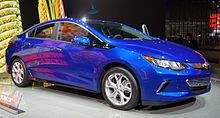
Since 2008, plug-in hybrids have been commercially available from both specialty manufacturers and from mainstream producers of internal combustion engine vehicles. The F3DM, released in China in December 2008, was the first production plug-in hybrid sold in the world.[60][61][62] The Chevrolet Volt, launched in the U.S. in December 2010, was the first mass-production plug-in hybrid by a major carmaker.[10]
Sales and main markets
[edit]There were 1.2 million plug-in hybrid cars on the world roads at the end of 2017.[190] The stock of plug-in hybrids increased to 1.8 million in 2018, out of a global stock of about 5.1 million plug-in electric passenger cars.[191][190] As of December 2017[update], the United States ranked as the world's largest plug-in hybrid car market with a stock of 360,510 units, followed by China with 276,580 vehicles, Japan with 100,860 units, the Netherlands with 98,220, and the UK with 88,660.[190]
Global sales of plug-in hybrids grew from over 300 units in 2010 to almost 9,000 in 2011, jumped to over 60,000 in 2012, and reached almost 222,000 in 2015.[94] As of December 2015[update], the United States was the world's largest plug-in hybrid car market with a stock of 193,770 units.[94] About 279,000 light-duty plug-in hybrids were sold in 2016,[192] raising the global stock to almost 800,000 highway legal plug-in hybrid electric cars at the end of 2016.[193][194] A total of 398,210 plug-in hybrid cars were sold in 2017, with China as the top selling country with 111,000 units, and the global stock of plug-in hybrids passed the one million unit milestone by the end of 2017.[190]

Global sales of plug-in electric vehicles have been shifting for several years towards fully electric battery cars. The global ratio between all-electrics (BEVs) and plug-in hybrids (PHEVs) went from 56:44 in 2012, to 60:40 in 2015, to 66:34 in 2017, and rose to 69:31 in 2018.[191][195]
By country
[edit]The Netherlands, Sweden, the UK, and the United States have the largest shares of plug-in hybrid sales as percentage of total plug-in electric passenger vehicle sales. The Netherlands has the world's largest share of plug-in hybrids among its plug-in electric passenger car stock, with 86,162 plug-in hybrids registered at the end of October 2016, out of 99,945 plug-in electric cars and vans, representing 86.2% of the country's stock of light-duty plug-in electric vehicles.[198]
Sweden ranks next with 16,978 plug-in hybrid cars sold between 2011 and August 2016, representing 71.7% of total plug-in electric passenger car sales registrations.[199][200][201][202][203] Plug-in hybrid registrations in the UK between up to August 2016 totaled 45,130 units representing 61.6% of total plug-in car registrations since 2011.[204] In the United States, plug-in hybrids represent 47.2% of the 506,450 plug-in electric cars sold between 2008 and August 2016.[205]
In November 2013 the Netherlands became the first country where a plug-in hybrid topped the monthly ranking of new car sales. During November sales were led by the Mitsubishi Outlander PHEV with 2,736 units, capturing a market share of 6.8% of new passenger cars sold that month.[206] Again in December 2013 the Outlander PHEV ranked as the top selling new car in the country with 4,976 units, representing a 12.6% market share of new car sales.[207][208] These record sales allowed the Netherlands to become the second country, after Norway, where plug-in electric cars have topped the monthly ranking of new car sales.[206][209] As of December 2013[update], the Netherlands was the country with highest plug-in hybrid market concentration, with 1.45 vehicles registered per 1,000 people.[210]
The following table presents the top ranking countries according to its plug-in hybrid segment market share of total new car sales in 2013:
| Top 10 countries by plug-in hybrid market share of new car sales in 2013[211] | |||||
|---|---|---|---|---|---|
| Ranking | Country | PHEV market share(1) (%) |
Ranking | Country | PHEV market share(1) (%) |
| 1 | 4.72% | 6 | 0.25% | ||
| 2 | 0.41% | 7 | 0.13% | ||
| 3 | 0.40% | 8 | 0.05% | ||
| 4 | 0.34% | 9 | 0.05% | ||
| 5 | 0.31% | 10 | 0.05% | ||
| Note: (1) Market share of highway-capable plug-in hybrids as percentage of total new car sales in the country in 2013. | |||||
By model
[edit]According to JATO Dynamics, in December 2018 the Mitsubishi Outlander PHEV was the world's all-time best selling plug-in hybrid.[4] Since inception, 290,000 units have been sold worldwide through September 2021.[5] Europe is the Outlander P-HEV leading market with 126,617 units sold through January 2019,[212] followed by Japan 42,451 units through March 2018.[213] European sales are led by the UK with 50,000 units by April 2020,[214] followed by the Netherlands with 25,489 units, and Norway with 14,196, both through March 2018.[213]
Combined global sales of the Chevrolet Volt and its variants totaled about 186,000 units by the end of 2018,[215][216][217][218][219] including about 10,000 Opel/Vauxhall Amperas sold in Europe through June 2016,[220] and over 4,300 Buick Velite 5s sold only in China (rebadged second generation Volt) through December 2018.[219] Volt sales are led by the United States with 152,144 units delivered through December 2018,[215] followed by Canada with 17,311 units through November 2018.[217][218] Until September 2018, the Chevrolet Volt was the world's top selling plug-in hybrid.[6]
Ranking third is the Toyota Prius Plug-in Hybrid (Toyota Prius Prime) with about 174,600 units sold worldwide of both generations through December 2018.[191][221] The United States is the leading market with over 93,000 units delivered through December 2018.[215] Japan ranks next with about 61,200 units through December 2018,[222][221] followed by Europe with almost 14,800 units through June 2018.[221][223]
The following table presents plug-in hybrid models with cumulative global sales of around or more than 100,000 units since the introduction of the first modern production plug-in hybrid car, the BYD F3DM, in 2008 up until December 2020:
| Top selling highway legal plug-in hybrid electric cars between 2008 and 2020 | |||||
|---|---|---|---|---|---|
| Model | Market launch |
Global sales | Cumulative sales through |
Sources | |
| Since inception | 2018 | ||||
| Mitsubishi Outlander PHEV | Jan 2013 | 290,000 | - | Sep 2021 | [5] |
| Chevrolet Volt(1) | Dec 2010 | ~186,000 | 25,108 | Dec 2018 | [215][216][217][219] |
| Toyota Prius PHV | Jan 2012 | 174,586 | 45,686 | Dec 2018 | [191][221] |
| BYD Qin(2) | Dec 2013 | 136,818 | 47,425 | Dec 2018 | [224][225][226] |
| BYD Tang(2) | Jun 2015 | 101,518 | 37,146 | Dec 2018 | [225][226][227][228] |
| Notes: (1) In addition to the Volt model sold in North America, combined sales of the Volt/Ampera family includes about 10,000 Vauxhall/Opel Ampera and 1,750 Volts sold in Europe,[229][93] 246 Holden Volt sold in Australia,[230] and 4,317 units of the Buick Velite 5 sold only in China (rebadged second generation Volt).[219] (2) Sales in China only. BYD Qin total does not include sales of the all-electric variant (Qin EV300). | |||||
Government support and public deployment
[edit]Subsidies and economic incentives
[edit]Several countries have established grants and tax credits for the purchase of new plug-in electric vehicles (PEVs) including plug-in hybrid electric vehicles, and usually the economic incentive depends on battery size. The U.S. offers a federal income tax credit up to US$7,500,[231] and several states have additional incentives.[232] The UK offers a Plug-in Car Grant up to a maximum of £5,000 (US$7,600).[233][234] As of April 2011, 15 of the 27 European Union member states provide tax incentives for electrically chargeable vehicles, which includes all Western European countries plus the Czech Republic and Romania. Also 17 countries levy carbon dioxide related taxes on passenger cars as a disincentive. The incentives consist of tax reductions and exemptions, as well as of bonus payments for buyers of all-electric and plug-in hybrid vehicles, hybrid vehicles, and some alternative fuel vehicles.[235][236]
Other government support
[edit]- United States
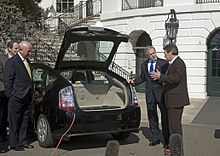
Incentives for the development of PHEVs are included in the Energy Independence and Security Act of 2007.[237] The Energy Improvement and Extension Act of 2008, signed into law on October 3, 2008, grants a tax credits for the purchase of PHEVs. President Barack Obama's New Energy for America calls for deployment of 1 million plug-in hybrid vehicles by 2015,[238] and on March 19, 2009, he announced programs directing $2.4 billion to electric vehicle development.[239]
The American Recovery and Reinvestment Act of 2009[240] modifies the tax credits, including a new one for plug-in electric drive conversion kits and for 2 or 3 wheel vehicles.[241] The ultimate total included in the Act that is going to PHEVs is over $6 billion.[242]
In March 2009, as part of the American Recovery and Reinvestment Act, the US Department of Energy announced the release of two competitive solicitations for up to $2 billion in federal funding for competitively awarded cost-shared agreements for manufacturing of advanced batteries and related drive components as well as up to $400 million for transportation electrification demonstration and deployment projects. This announcement will also help meet the President Barack Obama's goal of putting one million plug-in hybrid vehicles on the road by 2015.[243]
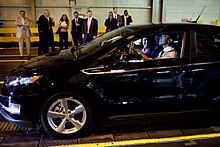
Public deployments also include:
- USDOE's FreedomCAR. US Department of Energy announced it would dole out $30 million in funding to three companies over three years to further the development of plug-in hybrids[244]
- USDOE announced the selection of Navistar Corporation for a cost-shared award of up to $10 million to develop, test, and deploy plug-in hybrid electric (PHEV) school buses.[245]
- DOE and Sweden have a MOU to advance market integration of plug-in hybrid vehicles[246]
- PHEV Research Center
- San Francisco Mayor Gavin Newsom, San Jose Mayor Chuck Reed and Oakland, California Mayor Ron Dellums announced a nine-step policy plan for transforming the Bay Area into the "Electric Vehicle (EV) Capital of the U.S."[247] and of the world[248] There are partnerships with Coulomb, Better Place and others are also advancing. The first charging stations went up in San Jose[248] (more information in Plug-in hybrids in California).
- Washington state PHEV Pilot Project[249]
- Texas Governor Rick Perry's proposal for a state $5,000 tax credit for PHEVs in "non-attainment" communities
- Seattle, that includes City's public fleet converted vehicles, the Port of Seattle, King County and the Puget Sound Clean Air Agency[250]
- European Union
Electrification of transport (electromobility) is a priority in the European Union Research Programme. It also figures prominently in the European Economic Recovery Plan presented November 2008, in the frame of the Green Car Initiative. DG TREN will support a large European "electromobility" project on electric vehicles and related infrastructure with a total budget of around €50 million as part of the Green Car Initiative.[251]
Supportive organizations
[edit]Organizations that support plug-in hybrids include the World Wide Fund for Nature,[252] National Wildlife Federation,[253] and CalCars.[254]
Other supportive organizations are Plug In America, the Alliance for Climate Protection, Friends of the Earth, the Rainforest Action Network, Rocky Mountain Institute (Project Get Ready),[255] the San Francisco Bay Area Council,[247] the Apollo Alliance, the Set America Free Coalition, the Silicon Valley Leadership Group, and the Plug-in Hybrid Electric School Bus Project.[256]
FPL and Duke Energy has said that by 2020 all new purchases of fleet vehicles will be plug-in hybrid or all-electric.[257]
See also
[edit]- Advanced Technology Vehicles Manufacturing Loan Program
- Electric transportation technology – Vehicle propelled by one or more electric motors
- Electric TM4 – Electric powertrain supplier
- Fuel economy-maximizing behaviors – Driving using techniques that reduce fuel consumption
- Glossary of automotive design
- Government incentives for plug-in electric vehicles
- Green vehicle – Environmentally friendly vehicles
- History of the electric vehicle
- Hymotion – Subsidiary company of A123Systems
- Hypercar – Rocky Mountain Institute's ultra-efficient car design
- Inductive charging – Type of wireless power transfer
- Patent encumbrance of large automotive NiMH batteries – Conspiracy theory
- Phase-out of fossil fuel vehicles
- Plug In America – electric vehicle advocacy group
- Plug-in electric vehicle – Type of vehicle (PEV)
- Plug-in Hybrid Electric Vehicle Research Center – Public university in Davis, California
- Range anxiety – Fear of insufficient vehicle range, especially in electric vehicles
- List of hybrid and plug-in hybrid vehicles
References
[edit]- ^ "BYD Song Pro DM - Sales in China". www.chinamobil.ru. Retrieved 2023-12-14.
- ^ a b "2021年全球新能源乘用车销量榜:冠亚军分别是特斯拉、比亚迪、上汽通用五菱-华夏EV网". www.evinchina.com. Retrieved 2024-04-30.
- ^ "【易车销量榜】全国2023年插电混动批发量销量榜-易车榜-易车". car.yiche.com. Retrieved 2024-01-21.
- ^ a b "Mitsubishi Outlander PHEV Hits 200,000 Global Sales Milestones" (Press release). Tokyo: Mitsubishi Motors Corporation (MMC). 2019-04-11. Archived from the original on 2019-04-12. Retrieved 2019-04-12.
- ^ a b c Mitsubishi Motors Corporation (2021-10-27). "Mitsubishi Motors Launches the All-New Outlander PHEV - PHEV Model of Flagship SUV Combines Leading Electrification and All-Wheel Control Technologies" (Press release). Tokyo: PR Newswire. Archived from the original on 2021-11-09. Retrieved 2021-11-08.
After the PHEV model was added to the previous generation in Japan in 2013, it was sequentially launched in regions including Europe, Oceania, North America and ASEAN, and has become a leader in the PHEV category with around 290,000 total units sold thus far. (As of September 2021)
- ^ a b c Pontes, Jose (2018-11-30). "Global All-Time Top 5 (Until Oct. '18 - Updated)". EVSales.com. Archived from the original on 2018-12-02. Retrieved 2019-02-01.
The sure values Mitsubishi Outlander PHEV and Chevrolet Volt follow (the Tesla Model S), with the Japanese SUV surpassing the GM hatchback
- ^ "Hybrid boats to revolutionise sustainable river travel". www.thamesclippers.com. Retrieved 2023-09-29.
- ^ a b c "BYD Auto To Begin Sales of F3DM Plug-in to Individuals". Green Car Congress. 2010-03-23. Archived from the original on 2010-03-26. Retrieved 2010-03-27.
- ^ a b "BYD Auto to Offer F3DM Plug-in Hybrid to Chinese Individuals Starting Next Week". Edmunds.com. 2010-03-23. Archived from the original on 2010-03-30. Retrieved 2010-03-27.
- ^ a b c "First Chevy Volts Reach Customers, Will Out-Deliver Nissan in December". plugincars.com. 2010-12-16. Archived from the original on 2010-12-18. Retrieved 2010-12-17.
- ^ "Mitsubishi Outlander PHEV Hits 200,000 Global Sales Milestone" (Press release). Tokyo: Mitsubishi Motors Corporation (MMC). 2019-04-11. Retrieved 2020-05-16.
- ^ 孙迟. "BYD releases 5th-generation DM hybrid technology with 2,100-km range". www.chinadaily.com.cn. Retrieved 2024-07-27.
- ^ "【易车销量榜】全国2023年比亚迪插电混动零售量销量榜-易车榜-易车". car.yiche.com. Retrieved 2024-02-25.
- ^ "【易车销量榜】全国2022年比亚迪插电混动零售量销量榜-易车榜-易车". car.yiche.com. Retrieved 2024-02-25.
- ^ "【易车销量榜】全国2020年比亚迪插电混动零售量销量榜-易车榜-易车". car.yiche.com. Retrieved 2024-03-01.
- ^ a b International Energy Agency (IEA) (June 2020). "Global EV Outlook 2020: Entering the decade of electric drive?". IEA Publications. Archived from the original on 2021-09-10. Retrieved 2020-06-15. See Statistical annex, pp. 247–252 (See Tables A.1 and A.12). The global stock of plug-in electric passenger vehicles totaled 7.2 million cars at the end of 2019, of which, 47% were on the road in China. The stock of plug-in cars consist of 4.8 million battery electric cars (66.6%) and 2.4 million plug-in hybrids (33.3%). In addition, the stock of light commercial plug-in electric vehicles in use totaled 378 thousand units in 2019, and about half a million electric buses were in circulation, most of which are in China.
- ^ James, Walter (September 2006). "Large Oil and GHG Reductions with Plug-in Hybrid Vehicles" (PDF). Alternative Transport Energies Conference, Perth, Australia. Archived from the original (PDF) on 2007-10-26. Retrieved 2019-10-22.
- ^ a b Tilsley, Rachelle (2017-03-07). "What is the difference between AC and DC Charging?". Electric Vehicle Charging Network. Archived from the original on 2018-05-07. Retrieved 2018-04-30.
- ^ "Making the Case for Grid-Connected Hybrids". EV World. 2001-09-23. Archived from the original on 2009-06-16. Retrieved 2010-03-10.
- ^ "What's In A Name?". EV World. 2005-04-07. Archived from the original on 2011-11-18. Retrieved 2010-03-10.
- ^ "The glossary". The Ergosphere. 2005-05-12. Archived from the original on 2010-02-07. Retrieved 2010-03-10.
- ^ Eberle, Ulrich; von Helmolt, Rittmar (2010-05-14). "Sustainable transportation based on electric vehicle concepts: a brief overview". Energy & Environmental Science. 3 (6). Royal Society of Chemistry: 689. doi:10.1039/C001674H. Archived from the original on 2021-03-07. Retrieved 2010-06-08.
- ^ "Chevy Volt: The Future is Electrifying". Chevrolet. Archived from the original on 2010-03-10. Retrieved 2010-03-05.
- ^ "History of Hybrid Vehicles". HybridCars.com. 2006-03-27. Archived from the original on 2009-09-04. Retrieved 2011-10-25. See year 1898.
- ^ "Lohner-Porsche Mixte Voiturette". Ultimate Car Page. 2007-11-19. Archived from the original on 2012-01-19. Retrieved 2011-10-25.
- ^ Fialka, John J. (2006-01-25). "Coalition Turns On to 'Plug-In Hybrids': Utilities, Localities, DaimlerChrysler Give Traction to Professor's Drive For High Mileage". The Wall Street Journal. Archived from the original on 2015-04-04. Retrieved 2011-06-21.
- ^ "Plug-In Hybrids: State Of Play, History & Players". CalCars. Archived from the original on 2015-05-02. Retrieved 2015-03-21.
- ^ Clayton, Mark (2008-07-19). "Can Plug-In Hybrids Ride to America's Rescue?". ABC News. Archived from the original on 2008-08-09. Retrieved 2009-04-18.
- ^ Boschert, Sherry (2006). Plug-in Hybrids: The Cars that will Recharge America. Gabriola Island, Canada: New Society Publishers. pp. 68–78. ISBN 978-0-86571-571-4. See Chapter 4
- ^ "Hybrid Car Ready in 1969". Finkbuilt. 2007-01-09. Archived from the original on 2007-05-09. Retrieved 2017-12-01.
- ^ Holinger, Heinrich (2003-10-11). "Renault Electric Kangoo Can Do". EVWorld.com. Archived from the original on 2008-02-05. Retrieved 2019-10-22.
- ^ "Kangoo reinvents the electric car" (PDF). Renault (Press release). March 10, 2003. Archived from the original (PDF) on 2007-04-12. Retrieved 2019-10-22.
- ^ Curtis D. Anderson, Judy Anderson, Electric and Hybrid Cars: A History, 2d ed. McFarland, 2010, ISBN 0786457422, page 156
- ^ "How We Green-Tuned an '04 Prius into a PRIUS+ Plug-In Hybrid!". CalCars.com – The California Cars Initiative. Archived from the original on 2016-05-29. Retrieved 2006-01-11.
- ^ Thomas, Ken (July 19, 2006). "Toyota charging ahead with plans for plug-in hybrid". Chicago Sun-Times/Associated Press. Archived from the original on November 2, 2007.
- ^ General Motors (November 29, 2006) "GM Announces Intention to Produce Plug-in Hybrid SUV" Archived 2011-06-10 at the Wayback Machine. Retrieved January 8, 2009.
- ^ Toyota Motor Corporation (July 25, 2007) "Japan Certifies Toyota Plug-in Hybrid for Public-road Tests" Archived 2007-09-28 at the Wayback Machine JCN Newswire. Retrieved July 25, 2007.
- ^ "Drive the Future with Fisker Automotive, A New Green American Premium Car Company" (PDF). 2007-09-05. Archived (PDF) from the original on 2009-03-20. Retrieved 2007-10-30.
- ^ Shirouzu, N., and Buckman, R. (January 14, 2008) "Electric-Car Firms Get Star Investors," Archived 2017-12-02 at the Wayback Machine Wall Street Journal
- ^ Motavalli, Jim (2011-12-02). "Unable to Raise Financing, Aptera Shuts Down". The New York Times. Archived from the original on 2012-10-15. Retrieved 2011-12-03.
- ^ Edmunds (October 15, 2007) "Detroit Show Preview: BYD's New Plug-in Hybrid on Sale Next Year" Archived 2007-10-19 at the Wayback Machine Edmunds Inside Line. Retrieved October 26, 2007.
- ^ "Ford Delivers First Escape Plug-In Hybrid To Southern California Edison". Media.Ford.Com (Press release). Archived from the original on 2011-11-18. Retrieved 2010-11-27.
- ^ "Ford Motor Company – Press Release – Ford Motor Company Delivers Flexible Fuel, Plug-In Vehicle to Department of Energy". Ford.com (Press release). Archived from the original on 2009-06-22. Retrieved 2010-11-27.
- ^ a b "Ford Escape Plug-in Hybrid". hybridCars.com. Archived from the original on 2009-09-12. Retrieved 2010-04-21.
- ^ a b "Ford Unveils 'Intelligent' System for Plug-In Hybrids To Communicate with the Electric Grid". Ford.com (Press release). Archived from the original on 2010-07-21. Retrieved 2010-11-27.
- ^ Plug-in car production race is on Archived 2008-06-22 at the Wayback Machine (Chicago Tribune)
- ^ "News Releases" (Press release). Toyota. 2008-01-14. Archived from the original on 2008-01-17. Retrieved 2010-11-27.
- ^ Ohnsman, A. (August 28, 2008) "Toyota Plans Electric Car, Earlier Plug-In Prius Test" Archived 2009-01-01 at the Wayback Machine Bloomberg. Retrieved December 2008.
- ^ "Preliminary Summary of Air Resources Board Action (3/27/08) – Zero Emission Vehicle (ZEV) Program" Archived 2008-05-16 at the Wayback Machine arb.ca.gov
- ^ California Air Resources Board (March 27, 2008) "ARB passes new ZEV amendment – Measure could produce 65,000 cleaner vehicles by 2012" Archived 2009-01-12 at the Wayback Machine (government agency release)
- ^ Thompson (June 26, 2008) "VW starts testing electric cars, sees launching them by 2010" (Forbes) accessed December 2009
- ^ "Mazda plans Volt rival". Autocar. 2008-08-28. Archived from the original on 2011-05-24. Retrieved 2010-11-27.
- ^ "Chrysler plans to sell electric car in 2010". Daily News. New York. Associated Press. 2008-09-23. Archived from the original on 2009-08-21. Retrieved 2015-03-15.
- ^ Spinelli, Mike (2008-09-23). "Chrysler Reveals Alternative-Energy Prototypes". Popular Science. Archived from the original on 2013-10-12. Retrieved 2015-03-15.
- ^ Schoenberger, R. (October 2, 2008) "Bailout bill includes tax breaks for buyers of plug-in hybrid vehicles," Archived 2008-10-06 at the Wayback Machine Cleveland Plain Dealer
- ^ Vijayenthiran, V. (October 3, 2008) "Bush signs $7,500 plug-in hybrid tax credit bill into law," Archived 2008-09-28 at the Wayback Machine MotorAuthority.com
- ^ "Nissan will sell electric car for just over $25K". Yahoo Finance. 2010-03-30. Archived from the original on 2010-04-05. Retrieved 2010-03-30.
- ^ Voelcker, John (2015-01-29). "2016 BYD Tang: Plug-In Hybrid SUV Is First Of Four To Come". Green Car Reports. Archived from the original on 2015-02-10. Retrieved 2015-02-17. BYD was the first company in the world to launch a production plug-in hybrid; its F3DM in 2008 was two years ahead of the 2011 Chevrolet Volt.
- ^ a b "BYD Launches Qin Plugin Hybrid – 189,800RMB to 209,800RMB". China Car Times. 2013-12-19. Archived from the original on 2013-12-21. Retrieved 2013-12-19.
- ^ a b Crippen, A. (December 15, 2008) "Warren Buffett's Electric Car Hits the Chinese Market, But Rollout Delayed For U.S. & Europe" CNBC. Retrieved December 2008.
- ^ a b Balfour, F. (December 15, 2008) "China's First Plug-In Hybrid Car Rolls Out" Archived 2008-12-20 at the Wayback Machine Business Week. Retrieved December 2008.
- ^ a b "BYD F3DM Plug-in Hybrid Goes On Sale in China". Green Car Congress. 2008-12-15. Archived from the original on 2009-03-04. Retrieved 2009-02-28.
- ^ "TMC Introduces 'Prius Plug-in Hybrid' into Key Markets" (Press release). Toyota News release. 2009-12-14. Archived from the original on 2017-06-30. Retrieved 2010-04-09.
- ^ English, Andrew (2010-01-05). "Toyota Plug-In Prius review". The Daily Telegraph. London. Archived from the original on 2010-01-09. Retrieved 2010-04-10.
- ^ a b "Lotus unveils range-extended electric city car concept in Paris". AutoblogGreen. 2010-10-02. Archived from the original on 2010-10-04. Retrieved 2010-10-05.
- ^ a b Gillies, Mark (2010-10-02). "Lotus City Car Concept – Auto Shows". Car and Driver. Archived from the original on 2010-10-05. Retrieved 2010-10-04.
- ^ Fehrenbacher, Katie (2011-07-26). "PHOTOS: Kleiner's Ray Lane receives his Fisker Karma". earth2tech. Archived from the original on 2011-12-17. Retrieved 2011-07-26.
- ^ Munday, Stephen (2011-09-30). "Prius Plug-In Hybrid On Sale January in Japan – Charging Stations at 5,500 Dealerships and Car Rental Locations". Integrity Exports. Archived from the original on 2011-10-02. Retrieved 2011-09-30.
- ^ Voelcker, John (2012-04-03). "Plug-In Car Sales Soar In March, Led By Chevrolet Volt". Green Car Reports. Archived from the original on 2012-04-06. Retrieved 2012-04-03.
- ^ "Solid 13% Q2 sales increase for Toyota and Lexus vehicles in Europe" (Press release). Toyota Motor Europe. 2012-07-13. Archived from the original on 2015-10-16. Retrieved 2012-08-06.
- ^ Motavalli, Jim (2012-11-02). "Ford's Electric Cars: Starting Slow, and Waiting for the Market". PluginCars.com. Archived from the original on 2012-11-04. Retrieved 2012-11-03.
- ^ "2013 (Q1) Sweden: Best-Selling Electric Cars and Plugin Hybrid Models". BestSellingCars.com. 2013-04-12. Archived from the original on 2013-06-05. Retrieved 2013-04-15.
- ^ Brissette, Pete (2013-01-21). "2014 Honda Accord Plug-in Hybrid Now Available in Calif. And New York". HybridCars.com. Archived from the original on 2013-01-25. Retrieved 2013-01-21.
- ^ Cole, Jay (2013-01-24). "Mitsubishi Outlander PHEV On Sale In Japan Today, Extended Promotional Video Released". Inside EVs. Archived from the original on 2013-01-27. Retrieved 2013-01-28.
- ^ Sears, Jesse (2013-02-27). "2013 Ford Fusion Energi: Fuel Economy, Pricing and Release Date". Cars Direct. Archived from the original on 2013-03-05. Retrieved 2013-03-03.
- ^ Cole, Jay (2013-03-03). "February 2013 Plug-In Electric Vehicle Sales Report Card". Inside EVs. Archived from the original on 2013-03-04. Retrieved 2013-03-04.
- ^ Webb, Alysha (2013-05-02). "China's BYD Opens Electric Bus Production Plant in California". PluginCars.com. Archived from the original on 2013-05-06. Retrieved 2013-05-11.
- ^ Nuñez, Beatriz. "BYD Presenta su Auto Híbrido Qin" [BYD Presents its Hybrid Car Qin] (in Spanish). Puro Motor. Archived from the original on 2013-12-16. Retrieved 2013-12-16.
- ^ "BYD Announces Sales Launch of Qin Electric Hybrid in Latin America". EV World. 2013-12-04. Archived from the original on 2013-12-16. Retrieved 2013-12-16.
- ^ Voelcker, John (2013-12-09). "BYD Qin Plug-In Hybrid Now On Sale In Costa Rica". Green Car Reports. Archived from the original on 2013-12-14. Retrieved 2013-12-16.
- ^ Joseph, Noah (2013-10-21). "McLaren P1 hits 62 mph in 2.8 seconds, 186 in 16.5". Autoblog.com. Archived from the original on 2013-10-21. Retrieved 2013-10-21.
- ^ Cole, Jay (2014-01-03). "Cadillac ELR Arrives Early, Manages To Sell 6 Copies In December". InsideEVs. Archived from the original on 2014-01-03. Retrieved 2014-01-03.
- ^ Loveday, Eric (2014-06-06). "World's First BMW i8 Owners Take Delivery In Germany". InsideEVs.com. Archived from the original on 2014-06-08. Retrieved 2014-06-07.
- ^ Gnaticov, Cristian (2014-06-03). "First Volkswagen XL1 gets delivered to German customer". Inautonews. Archived from the original on 2014-06-07. Retrieved 2014-06-07.
- ^ Kane, Mark (2014-09-24). "Germany Plug-In Electric Vehicle Sales Report August 2014". InsideEVs.com. Archived from the original on 2014-09-29. Retrieved 2014-09-29.
- ^ Loveday, Eric (2014-12-01). "BMW Commits To Offering Plug-In Hybrid Versions Of All Core-Brand Models". InsideEVs.com. Archived from the original on 2014-12-04. Retrieved 2014-12-02.
- ^ Edelstein, Stephen (2015-03-06). "2016 BMW X5 xDrive 40e Plug-In Hybrid SUV To Debut In Shanghai Next Month". Green Car Reports. Archived from the original on 2015-03-18. Retrieved 2015-03-21.
- ^ Thevenot, Brian & Hirsch, Jerry (2015-01-12). "Chevy Bolt electric car targets Tesla with low price, long range". Los Angeles Times. Archived from the original on 2015-01-13. Retrieved 2015-01-13.
- ^ Cobb, Jeff (2015-11-03). "2016 Volts Account For 1,324 Sales Out Of 2,035 October Deliveries". HybridCars.com. Archived from the original on 2015-11-07. Retrieved 2015-11-03.
- ^ Klippenstein, Matthew (2015-11-06). "Plug-in Electric Car Sales in Canada, October 2015: The Wallet Ballot". Green Car Reports. Archived from the original on 2015-11-07. Retrieved 2015-11-07.
- ^ Millikin, Mike (2015-03-11). "Audi to have a plug-in hybrid in every model series; new BEV in 2018". Green Car Congress. Archived from the original on 2015-03-14. Retrieved 2015-03-21.
- ^ Millikin, Mike (2015-03-18). "Mercedes-Benz to introduce 10 plug-in hybrids by 2017; GLE PHEV coming soon". Green Car Congress. Archived from the original on 2015-03-20. Retrieved 2015-03-21.
- ^ a b Cobb, Jeff (2015-11-04). "GM Sells Its 100,000th Volt in October". HybridCars.com. Archived from the original on 2015-11-08. Retrieved 2015-11-06.About 102,000 units of the Volt/Ampera family have been sold worldwide by the end of October 2015.
- ^ a b c International Energy Agency (IEA), Clean Energy Ministerial, and Electric Vehicles Initiative (EVI) (May 2016). "Global EV Outlook 2016: Beyond one million electric cars" (PDF). IEA Publications. Archived from the original (PDF) on 2016-08-24. Retrieved 2016-09-07.
{{cite web}}: CS1 maint: multiple names: authors list (link) See pp. 4–5, and 24–25 and Statistical annex, pp. 34–37. - ^ Cobb, Jeff (2016-01-18). "Top Six Plug-in Vehicle Adopting Countries – 2015". HybridCars.com. Archived from the original on 2016-02-04. Retrieved 2016-02-12. About 520,000 highway legal light-duty plug-in electric vehicles were sold worldwide in 2015, with cumulative global sales reaching 1,235,000. Plug-in hybrids represent about 40% of global plug-in electric vehicle sales Archived 2015-09-17 at the Wayback Machine.
- ^ "BMW at the 86th Geneva International Motor Show 2016" (Press release). Munich: BMW Group PressClub Global. 2016-02-12. Archived from the original on 2021-11-23. Retrieved 2016-02-12.
- ^ Blanco, Sebastian (2016-03-22). "BMW 330e iPerformance brings new name to $44,695 PHEV". Autoblog.com. Archived from the original on 2016-03-23. Retrieved 2016-03-22.
- ^ Jin-hai, Park (2016-01-14). "Hyundai launches Ioniq hybrid compact". The Korea Times. Archived from the original on 2016-03-06. Retrieved 2016-03-02.
- ^ Millikin, Mike (2016-03-24). "Hyundai unveils Ioniq HEV, PHEV and EV for US market at New York show". Green Car Congress. Archived from the original on 2016-03-27. Retrieved 2016-03-24.
- ^ Cole, Jay (2016-02-21). "Hyundai IONIQ Electric Has A 28 kWh Battery, 105 Miles Real Range". InsideEVs.com. Archived from the original on 2016-03-04. Retrieved 2016-03-02.
- ^ a b Kageyama, Yuri (2016-06-17). "Toyota gets bullish on plug-in hybrids with new Prius Prime". Japan Today. Archived from the original on 2016-06-17. Retrieved 2016-06-17.
- ^ Cole, Jay (2016-12-02). "Several Plug-Ins Hit New 2016 Highs, As November EV Sales In US Rise Sharply". InsideEVs.com. Archived from the original on 2016-12-03. Retrieved 2016-12-02.
- ^ Blanco, Sebastian (2016-03-23). "Toyota Prius Prime plugs in with 22 EV miles". Autoblog.com. Archived from the original on 2016-03-24. Retrieved 2016-03-24.
- ^ LeSage, Jon (2016-10-05). "2017 Prius Prime Offers Industry's Best 'MPGe' and 25 Miles Electric Range". HybridCars.com. Archived from the original on 2016-10-12. Retrieved 2016-10-15.
- ^ Voelcker, John (2016-10-10). "At 133 MPGe, Toyota Prius Prime wallops BMW i3 on energy efficiency". Green Car Reports. Archived from the original on 2016-10-15. Retrieved 2016-10-15.
- ^ Halvorson, Bengt (2016-03-24). "2016 Toyota Prius Prime: details on 120 MPGe plug-in hybrid, all-electric mode". Green Car Reports. Archived from the original on 2016-03-27. Retrieved 2016-03-24.
- ^ Cobb, Jeff (2016-05-03). "Mitsubishi Sells 100,000th Outlander PHEV". HybridCars.com. Archived from the original on 2016-05-04. Retrieved 2016-05-03. As of March 2016[update], the world's top selling plug-in electric cars are the Nissan Leaf (over 218,000), Tesla Model S (about 120,000), Chevrolet Volt and Ampera variants (over 110,000), Mitsubishi Outlander PHEV (over 100,000), and Toyota Prius Plug-in Hybrid (75,000). All figures cumulative global sales since market launch.
- ^ "Global Mitsubishi Outlander PHEV Sales Pass the 100,000 Mark" (Press release). UK: Mitsubishi Motors UK. 2016-05-19. Archived from the original on 2016-06-24. Retrieved 2016-05-22. As of March 2016[update], a total of 65,529 units have been sold in Europe (21,052 in the UK and 44,477 in the rest of Europe), 33,730 in Japan, 2,015 in Australia and 259 in the rest of the world, for a total of 101,533 units sold worldwide.
- ^ Cobb, Jeff (2016-05-19). "China's BYD Qin PHEV Sells 50,000th Unit As Quickly As Did The Chevy Volt". HybridCars.com. Archived from the original on 2016-05-20. Retrieved 2016-05-19.
- ^ Greimel, Hans (2016-06-25). "Nissan's to-do list: Range, autonomy". Automotive News. Retrieved 2016-06-27.
- ^ "Chrysler introduces Pacifica plug-in hybrid minivan; 80 mpge city, 30-mile AER". Green Car Congress. 11 January 2016. Archived from the original on 28 November 2020. Retrieved 26 January 2021.
- ^ "2018 Honda Clarity Plug-in Hybrid Pricing to Start at $33,400". Honda.com (Press release). US. 2017-11-16. Archived from the original on 2017-12-28. Retrieved 2017-12-28.
- ^ "XL1".
- ^ "2014 Volkswagen XL1 First Drive". 14 June 2013.
- ^ "For Sale: Ultra-Rare 2015 Volkswagen XL1 Diesel-Hybrid Capable of 260 MPG". 22 December 2019.
- ^ Holger Wittich, Patrick Lang (2021-02-22). "Neue Mercedes C-Klasse (W206)". auto motor und sport.
- ^ Perkins, Chris (2023-02-11). "How Electric Turbochargers Are Changing Internal Combustion". Rand and Track. US. Retrieved 2024-05-19.
- ^ ""AC Propulsion's Reductive Charger"". Archived from the original on January 7, 2011.
- ^ "Plug-ins Progress". Green Car Congress. 2006-09-29. Archived from the original on 2017-12-05. Retrieved 2017-12-30.
- ^ a b Gonder, J.; Markel, T. (2007-04-16). Energy Management Strategies for Plug-In Hybrid Electric Vehicles (PDF). SAE World Congress. Detroit. NREL/CP-540-40970. Archived from the original (PDF) on 2007-09-25.
- ^ Shiau, C.-S.; Samaras, C.; Hauffe, R.; Michalek, J.J. (2009). "Impact of battery weight and charging patterns on the economic and environmental benefits of plug-in hybrid vehicles" (PDF). Archived (PDF) from the original on 2011-06-08. Retrieved 2010-11-27.
- ^ Romm, Joseph J.; Frank, Andrew A. (April 2006). "Hybrid Vehicles Gain Traction" (PDF). Scientific American. pp. 72–79. Archived (PDF) from the original on 2018-10-19. Retrieved 2017-12-30 – via The California Cars Initiative.
- ^ Bullis, Kevin (2006-08-03). "Are Lithium-Ion Electric Cars Safe?". Technology Review. Cambridge, Mass.: MIT. Archived from the original on 2021-11-23. Retrieved 2017-12-30.
- ^ Fleissner, Chris (2006-08-14). "Johnson Controls partnership wins new contract". Wisconsin Technology Network. Archived from the original on 2007-03-11. Retrieved 2017-12-30.
- ^ "Altair Nanotechnologies Details Long Life Features of its Nano Titanate Battery". Business Wire (Press release). Nano Science and Technology Institute. 2006-09-07. Archived from the original on 2007-09-27.
- ^ Voelcker, John (2007-01-02). "Lithium Batteries for Hybrid Cars". IEEE Spectrum. Archived from the original on 2007-01-22. Retrieved 2017-12-30.
- ^ "How hybrids work". Canada: Toyota. 2016. Archived from the original on 2016-06-28. Retrieved 2016-07-07.
- ^ Woody, Todd. "PG&E's Battery Power Plans Could Jump Start Electric Car Market". (Blog). Green Wombat, 2007-06-12. Retrieved 2007-08-19.
- ^ Jansen, Matt. "Toyota laughs while Chevy Volt battery power is ripped in half". Archived 2008-06-17 at the Wayback Machine (Blog). tech.blorge, 2008-6-16. Retrieved 2008-6-17.
- ^ Wald, M. L. (2008-01-13). "Closing the Power Gap Between a Hybrid's Supply and Demand". The New York Times. Archived from the original on 2009-04-10. Retrieved 2009-01-07.
- ^ Downing, Jim (2008-05-21). "Plug-in hybrids promise more power, greater efficiency". The Sacramento Bee. Archived from the original on 2008-05-28.
- ^ "UltraBattery FAQs" Archived 2011-04-15 at the Wayback Machine, 2010-05-06
- ^ "Can Congress Hear From 6,692 Plug-In Supporters Today?". Calcars.org. Archived from the original on 2009-06-04. Retrieved 2009-04-11.
- ^ "Calcars.org" (PDF). Archived (PDF) from the original on 2010-11-26. Retrieved 2010-11-27.
- ^ "Calcars.org". Calcars.org. Archived from the original on 2010-11-26. Retrieved 2010-11-27.
- ^ California Cars Initiative (2007) "Where Plug-In Hybrid Conversions (mostly Priuses) Are" Archived 2007-07-14 at the Wayback Machine. Retrieved July 8, 2007.
- ^ A123 Systems, Inc. (May 3, 2007) A123Systems Battery Co Acquires Hymotion Conversion Co Archived 2012-07-07 at archive.today Business Wire press release
- ^ Stewart, James (2018-01-11). "Electric Vehicle Tax Credit Survives, but G.M. and Tesla Aren't Cheering". The New York Times. Archived from the original on 2018-05-07. Retrieved 2018-04-30.
- ^ "Atlanta's Incentives Lift Electric Car Sales Tax Credit, Cheap Power Help Make Georgia Capitol a Hotbed for Battery Buggies". The Wall Street Journal. 4 June 2014. Archived from the original on 6 June 2014. Retrieved 13 October 2014.
Atlanta has been the top U.S. market for Nissan's Leaf car for eight of the past 10 months
- ^ "Gauging interest for plug-in hybrid and electric vehicles in select markets: Alternative powertrain survey highlights". EY. Archived from the original on 24 September 2015. Retrieved 13 October 2014.
- ^ "Summary of Travel Trends: 2009 National Household Travel Survey" (PDF). U.S. Department of Transportation – Federal Highway Administration. p. 13. Archived (PDF) from the original on 31 October 2014. Retrieved 12 October 2014.
- ^ "2011 Census Analysis, Distance Travelled to Work". Office for National Statistics (UK). 26 March 2014. Archived from the original on 24 September 2015. Retrieved 12 October 2014.
- ^ Austin, Michael. "4 Top Plug-in Hybrids, Tested". Popular Mechanics. Archived from the original on 18 October 2014. Retrieved 12 October 2014.
- ^ Edsall, Larry (2010). Endres, Chris (ed.). Chevrolet Volt: Charging into the Future. Foreword by Bob Lutz. Minneapolis, Minnesota: Quarto Group Motorbooks. pp. 91–16. ISBN 978-0-7603-3893-3.
- ^ "GM to unveil Volt electric concept car". NBC News. Associated Press. 2007-01-07. Archived from the original on 2016-03-05. Retrieved 2011-05-15.
- ^ Loveday, Eric (2014-10-03). "Chevy Volt Owners Pass 1 Billion Total Miles". InsideEVs.com. Archived from the original on 2014-10-07. Retrieved 2014-10-13.
- ^ Millikin, Mike (2016-05-27). "2017 Ford Fusion Energi PHEV boosts total range to 610 miles". Green Car Congress. Archived from the original on 2016-05-28. Retrieved 2016-05-27.
- ^ "Light-Duty Automotive Technology, Carbon Dioxide Emissions, and Fuel Economy Trends: 1975 Through 2015" (PDF). U.S. Environmental Protection Agency. December 2015. Archived from the original (PDF) on 2016-06-02. Retrieved 2016-05-15. See Table 7.2 – MY 2015 Alternative Fuel Vehicle Powertrain and Range.
- ^ Nelson, Gabe (2015-03-28). "Calif. considers a plea for plug-in hybrids". Automotive News. Retrieved 2015-03-28.
- ^ International Humanities Center (September 24, 2008) "Senate OKs Plug-In Credits, Toyota Frets; Free Press Lyrical about Plug-Ins" Archived 2010-09-19 at the Wayback Machine California Cars Initiative
- ^ Grove, Andy (July/August 2008) "Our Electric Future" Archived 2014-08-25 at the Wayback Machine The American (American.com)
- ^ a b U.S. Environmental Protection Agency and U.S. Department of Energy (2011-05-27). "2011 Chevrolet Volt". Fueleconomy.gov. Archived from the original on 2011-07-21. Retrieved 2011-05-31.
- ^ a b "Volt receives EPA ratings and label: 93 mpg-e all-electric, 37 mpg gas-only, 60 mpg-e combined". Green Car Congress. 2010-11-24. Archived from the original on 2011-06-15. Retrieved 2011-05-31.
- ^ a b "EPA, DOT unveil the next generation of fuel economy labels". Green Car Congress. 2011-05-25. Archived from the original on 2011-05-29. Retrieved 2011-05-31.
- ^ a b "Fact Sheet: New Fuel Economy and Environment Labels for a New Generation of Vehicles". U.S. Environmental Protection Agency. May 2011. Archived from the original on 2011-05-29. Retrieved 2011-05-31.EPA-420-F-11-017
- ^ US Department of Energy (September 18, 2007) "Plug-In Hybrid Electric Vehicle Conversions" Archived 2007-10-31 at the Wayback Machine Alternative Fuels and Advanced Vehicles Data Center Retrieved November 8, 2007.
- ^ Hamilton, Tyler. $3.83 to power hybrid plug-in for 6 days Archived 2012-10-19 at the Wayback Machine. June 9, 2008
- ^ Westneat, D. (February 22, 2009) Reality check on plug-in cars Archived 2009-02-25 at the Wayback Machine
- ^ "RechargeIT.org". Google.org. Archived from the original on 2009-03-08. Retrieved 2009-04-11.
- ^ "Google.org". Google.org. Archived from the original on 2009-03-21. Retrieved 2009-04-11.
- ^ Xing Wu; Jing Dong; Zhenhong Lin (2014-03-11). "Study finds energy savings of PHEVs relative to HEVs dependent on charging coverage and daily VMT". Green Car Congress. Archived from the original on 2014-03-23. Retrieved 2014-03-23. For more details see: Xing Wu, Jing Dong, Zhenhong Lin (2014) Cost analysis of plug-in hybrid electric vehicles using GPS-based longitudinal travel data, Energy Policy, Volume 68, Pages 206–217, doi: 10.1016/j.enpol.2013.12.054
- ^ a b c National Research Council (2010). Transitions to Alternative Transportation Technologies—Plug-in Hybrid Electric Vehicles. The National Academies Press. doi:10.17226/12826. ISBN 978-0-309-14850-4. Archived from the original on 2011-06-07. Retrieved 2010-03-03.
- ^ a b c Jad Mouawad & Kate Galbraith (2009-12-14). "Study Says Big Impact of the Plug-In Hybrid Will Be Decades Away". The New York Times. Archived from the original on 2014-08-10. Retrieved 2010-03-04.
- ^ a b c d National Research Council (2009-12-14). "Plug-In Hybrid Vehicle Costs Likely to Remain High, Benefits Modest for Decades". U.S. National Academy of Sciences. Archived from the original on 2010-02-01. Retrieved 2010-03-04.
- ^ Tabuchi, Hiroko (2009-12-14). "Toyota to Sell Plug-In Hybrid in 2011". The New York Times. Archived from the original on 2016-02-02. Retrieved 2010-02-03.
- ^ Siddiq Khan & Martin Kushler (June 2013). "Plug-in Electric Vehicles: Challenges and Opportunities" (PDF). American Council for an Energy-Efficient Economy. Archived (PDF) from the original on 2016-05-12. Retrieved 2013-07-09. ACEEE Report Number T133.
- ^ a b Henry Lee & Grant Lovellette (July 2011). "Will Electric Cars Transform the U.S. Vehicle Market?". Belfer Center for Science and International Affairs, Kennedy School of Government. Archived from the original on 2011-08-12. Retrieved 2011-08-07.
- ^ Henry Lee & Grant Lovellette (July 2011). "WillElectricCars Transform the U.S. Vehicle Market?" (PDF). Belfer Center for Science and International Affairs, Kennedy School of Government. Archived (PDF) from the original on 2011-08-01. Retrieved 2011-08-07. Discussion Paper #2011-08.
- ^ Knipping, E. and Duvall, M. (June 2007) "Environmental Assessment of Plug-In Hybrid Electric Vehicles Volume 2: United States Air Quality Analysis Based on AEO-2006 Assumptions for 2030" Electric Power Research Institute and Natural Resources Defense Council. Retrieved July 21, 2007.
- ^ Clayton, M. (September 25, 2006) "A reality check on plug-in hybrids" Archived 2006-10-05 at the Wayback Machine The Christian Science Monitor
- ^ Kanellos, M. (2006-04-28). "Plug in your hybrid, pollute less?". CNET News. Archived from the original on 2012-07-14.
{{cite news}}: CS1 maint: bot: original URL status unknown (link) - ^ "Hidden Costs of Energy: Unpriced Consequences of Energy Production and Use". National Academy of Science. 2009-10-19. Archived from the original on 2010-05-25. Retrieved 2010-05-29.
- ^ Technology Options 2003. Archived 2008-02-16 at the Wayback Machine (2003). US Climate Change Technology Program.
- ^ "Question: Where can I find data on electricity transmission and distribution losses?". Frequently Asked Questions – Electricity. U.S. Energy Information Administration. 2009-11-19. Archived from the original on 2010-04-01. Retrieved 2010-03-28.
- ^ Bullis, K. (2006-12-21). "How Plug-in Hybrids Will Save the Grid". Technology Review.
- ^ a b c Sperling, Daniel; Gordon, Deborah (2009). Two billion cars: driving toward sustainability. Oxford University Press, New York. pp. 22 to 26 and 114–139. ISBN 978-0-19-537664-7.
- ^ a b David B. Sandalow, ed. (2009). Plug-In Electric Vehicles: What Role for Washington? (1st. ed.). The Brookings Institution. ISBN 978-0-8157-0305-1. Archived from the original on 2019-03-28. Retrieved 2019-01-04. pages=2–5
- ^ a b c d A. Elgowainy; A. Burnham; M. Wang; J. Molburg & A. Rousseau (February 2009). "Well-to-Wheels Energy Use and Greenhouse Gas Emissions Analysis of Plug-in Hybrid Electric Vehicles" (PDF). Center for Transportation Research, Argonne National Laboratory. Archived (PDF) from the original on 2009-05-07. Retrieved 2006-06-01. Report ANL/ESD/09-2
- ^ Searchinger, Timothy; et al. (2008-02-29). "Use of U.S. Croplands for Biofuels Increases Greenhouse Gases Through Emissions from Land-Use Change". Science. 319 (5867): 1238–1240. Bibcode:2008Sci...319.1238S. doi:10.1126/science.1151861. PMID 18258860. S2CID 52810681. Originally published online in Science Express on 2008-02-07. See Letters to Science by Wang and Haq. There are critics to these findings for assuming a worst-case scenario.
- ^ Fargione, Joseph; Hill, Jason; Tilman, D; Polasky, S; Hawthorne, P; et al. (2008-02-29). "Land Clearing and the Biofuel Carbon Debt". Science. 319 (5867): 1235–1238. Bibcode:2008Sci...319.1235F. doi:10.1126/science.1152747. PMID 18258862. S2CID 206510225. Originally published online in Science Express on 2008-02-07. There are rebuttals to these findings for assuming a worst-case scenario
- ^ a b Hadley, Stanton W. & Tsvetkova, Alexandra (January 2008). "Potential Impacts of Plug-in Hybrid Electric Vehicles on Regional Power Generation" (PDF). Oak Ridge National Laboratory. Archived (PDF) from the original on 2012-10-15. Retrieved 2010-08-23. Report ORNL/TM-2007/150
- ^ Moyer, Michael (July 2010). "The Dirty Truth about Plug-in Hybrids". Scientific American. Archived from the original on 2010-06-25. Retrieved 2010-08-23.
- ^ "Different energy mixes will fuel plug-in hybrid cars". Argonne National Laboratory. 2010-08-17. Archived from the original on 2010-08-24. Retrieved 2010-08-23.
- ^ Amgad Elgowainy; J. Han; L. Poch; M. Wang; A. Vyas; M. Mahalik & A. Rousseau (June 2010). "Well-to-Wheels Analysis of Energy Use and Greenhouse Gas Emissions of Plug-in Hybrid Electric Vehicles" (PDF). Argonne National Laboratory. Archived (PDF) from the original on 2011-07-16. Retrieved 2010-08-23.
- ^ a b c d e U. S. Environmental Protection Agency (October 2014). "Light-Duty Automotive Technology, Carbon Dioxide Emissions, and Fuel Economy Trends: 1975 Through 2014" (PDF). EPA. Archived (PDF) from the original on 2015-04-02. Retrieved 2014-10-12. See table 7.3 - Overall fuel economy (mpg-e), pp. 100.
- ^ Millikin, Mike (2014-10-11). "EPA Trends on EVs and PHEVs; beginning of a "measurable and meaningful impact" on new vehicle fuel economy and emissions". Green Car Congress. Archived from the original on 2014-10-16. Retrieved 2014-10-11.
- ^ U.S. Environmental Protection Agency and U.S. Department of Energy (2014-09-10). "Model Year 2014 Fuel Economy Guide – Electric vehicles & Plug-in Hybrid Electric Vehicles (updated September 2014)" (PDF). fueleconomy.gov. Archived (PDF) from the original on 2014-10-14. Retrieved 2014-09-12. pp. 33–36
- ^ "The ZEV's invisible tailpipe – Are zero-emission vehicles cleaner than petrol cars? It all depends..." The Economist. 2014-11-24. Archived from the original on 2014-12-07. Retrieved 2014-12-08.
- ^ a b c Graff Zivina, Joshua S.; Kotchenb, Matthew J.; Mansur, Erin T. (November 2014). "Spatial and temporal heterogeneity of marginal emissions: Implications for electric cars and other electricity-shifting policies" (PDF). Journal of Economic Behavior and Organization. 107 (Part A): 248–268. doi:10.1016/j.jebo.2014.03.010. Archived (PDF) from the original on 2018-06-02. Retrieved 2019-07-01. Published on line 2014-03-24. See pp. 251
- ^ a b c d International Energy Agency (IEA), Clean Energy Ministerial, and Electric Vehicles Initiative (EVI) (May 2018). "Global EV Outlook 2017: 3 million and counting" (PDF). IEA Publications. Archived (PDF) from the original on 2020-06-16. Retrieved 2018-12-16.
{{cite web}}: CS1 maint: multiple names: authors list (link) See pp. 9–10, 19–23, 29–28, and Statistical annex, pp. 107–113. - ^ a b c d e Jose, Pontes (2019-01-31). "Global Top 20 - December 2018". EVSales.com. Archived from the original on 2019-02-01. Retrieved 2019-02-02. "Global sales totaled 2,018,247 plug-in passenger cars in 2018, with a BEV:PHEV ratio of 69:31, and a market share of 2.1%. The world's top selling plug-in car was the Tesla Model 3, and Tesla was the top selling manufacturer of plug-in passenger cars in 2018, followed by BYD."
- ^ Jose, Pontes (31 January 2017). "World Top 20 December 2016 (Updated)". EVSales.com. Archived from the original on 5 February 2017. Retrieved 5 February 2017. Global light-duty plug-in vehicles sales totaled almost 775,000 units in 2016, of which, 36% were plug-in hybrids.
- ^ "Global Plug-in Sales for 2016". EV-Volumes.com. February 2017. Archived from the original on 2017-02-05. Retrieved 2017-02-05.
- ^ Cobb, Jeff (2017-01-16). "The World Just Bought Its Two-Millionth Plug-in Car". HybridCars.com. Archived from the original on 2017-01-18. Retrieved 2017-01-17. An estimated 2,032,000 highway-legal plug-in passenger cars and vans have been sold worldwide at the end of 2016. The top selling markets are China (645,708 new energy cars, including imports), Europe (638,000 plug-in cars and vans), and the United States (570,187 plug-in cars). The top European country markets are Norway (135,276), the Netherlands (113,636), France (108,065), and the UK (91,000). Total Chinese sales of domestically produced new energy vehicles, including buses and truck, totaled 951,447 vehicles. China was the top selling plug-in car market in 2016, and also has the world's largest stock of plug-in electric cars.
- ^ a b Hertzke, Patrick; Müller, Nicolai; Schenk, Stephanie; Wu, Ting (May 2018). "The global electric-vehicle market is amped up and on the rise". McKinsey & Company. Archived from the original on 2019-01-28. Retrieved 2019-01-27. See Exhibit 1: Global electric-vehicle sales, 2010-17.
- ^ Jose, Pontes (2020-01-31). "Global Top 20 - December 2019". EVSales.com. Archived from the original on 2020-12-27. Retrieved 2020-05-10. "Global sales totaled 2,209,831 plug-in passenger cars in 2019, with a BEV to PHEV ratio of 74:26, and a global market share of 2.5%. The world's top selling plug-in car was the Tesla Model 3 with 300,075 units delivered, and Tesla was the top selling manufacturer of plug-in passenger cars in 2019 with 367,820 units, followed by BYD with 229,506."
- ^ IEA 2024
- ^ Cobb, Jeff (2016-11-17). "The Netherlands Becomes Sixth Country To Buy 100,000 Plug-in Vehicles". HybridCars.com. Archived from the original on 2016-11-18. Retrieved 2016-11-18.
- ^ "2012 (Full Year) Sweden: Best-Selling Electric Cars & Plug-In Hybrid Models". BestSellingCars.com. 2013-04-02. Archived from the original on 2013-06-05. Retrieved 2013-07-05.
- ^ "Nyregistreringar december 2013 prel" [New registrations in December 2013 prel] (in Swedish). Bil Sweden. 2014-01-02. Archived from the original on 2014-01-03. Retrieved 2014-01-03. Download file "Nyregistreringar December 2013 prel.pdf" see table "NYREGISTRERADE SUPERMILJÖBILAR DECEMBER 2013" with summary of PEV sales by model for 2013 and 2012.
- ^ "Nyregistreringar december 2014 (prel)" [New registrations in December 2014 (preliminar)] (in Swedish). Bil Sweden. 2015-01-02. Archived from the original on 2015-01-04. Retrieved 2015-01-04. Download file "Nyregistreringar december 2014 (prel)" see tables: "Nyregistrerade supermiljöbilar december 2014" with summary of plug-in passenger car registrations by model for 2013 (revised) and 2014, and table "Nyregistrerade eldrivna lätta lastbilar (högst 3,5 ton) per modell:" for plug-in utility vans registrations for the same two years. A total of 303,866 new passenger vehicles were registered in 2014, and a total of 4,656 super clean cars, resulting in a PEV market share of 1.53% of new car sales.
- ^ "Nyregistreringar december 2015 def" [New Registrations December 2015 (final)] (in Swedish). Bil Sweden. 2016-01-04. Archived from the original on 2016-04-15. Retrieved 2016-04-15. Download the pdf file "Nyregistreringar december 2015 def" (PressRel1512_def.pdf) See table: Nyregistrerade miljöpersonbilar december 2015.
- ^ "Nyregistreringar augusti 2016 (II)" [New Registrations August 2016 (II)] (in Swedish). Bil Sweden. 2016-09-01. Archived from the original on 2016-09-19. Retrieved 2016-09-18. Download the pdf file "Nyregistreringar augusti 2016 (II)" (PressRel1608II.pddf) See table: "Nyregistrerade miljöbilar per typ augusti 2016." A total of 6,129 plug-in hybrids and 1,627 all-electric cars were registered during the first eight months of 2016.
- ^ "December 2013 – EV and AFV registrations". Society of Motor Manufacturers and Traders (SMMT). 2014-01-07. Archived from the original on 2014-01-18. Retrieved 2014-01-25. A total of 992 plug-in hybrids were registered during 2012 and 1,072 in 2013.
- ^ Cobb, Jeff (2016-09-01). "Americans Buy Their Half-Millionth Plug-in Car". HybridCars.com. Archived from the original on 2016-09-03. Retrieved 2016-09-02. See details in captions and graphs.
- ^ a b "Mitsubishi Outlander PHEV top seller". Automotive Industry Data (AID). 2013-12-17. Archived from the original on 2013-12-20. Retrieved 2013-12-26.
- ^ Pontes, Jose (2014-01-04). "Netherlands December 2013". EV Sales. Archived from the original on 2014-01-06. Retrieved 2014-01-05.
- ^ Gasnier, Mat (2013-12-04). "Netherlands November 2013: Mitsubishi Outlander shoots up to pole position!". Best Selling Cars Blog. Archived from the original on 2014-01-06. Retrieved 2013-12-26.
- ^ Gasnier, Mat (2014-01-03). "Netherlands December 2013: Mitsubishi Outlander at 12.7% share, Volvo V40 and V60 on podium". Best Selling Cars Blog. Archived from the original on 2014-01-08. Retrieved 2014-01-05.
- ^ Cobb, Jeff (2014-01-16). "Top 6 Plug-In Vehicle Adopting Countries". HybridCars.com. Archived from the original on 2016-05-10. Retrieved 2016-08-29. Around 1,800 Tesla Roadsters and 1,600 Fisker Karmas had been sold in the U.S. by the end of 2013.
- ^ Shahan, Zachary (2013-03-07). "Electric vehicle market share in 19 countries – Plug-in Hybrid EV Market Share in 2013". ABB Conversations. Archived from the original on 2014-04-13. Retrieved 2014-04-12.
- ^ Kane, Mark (2019-03-13). "Outlander PHEV Is Best-Selling Mitsubishi In Europe". InsideEVs.com. Archived from the original on 2019-04-16. Retrieved 2019-04-12.
- ^ a b "New (MY19) Mitsubishi Outlander PHEV - Summer 2018" (PDF) (Press release). Mitsubishi Motors. 2018. Archived (PDF) from the original on 2018-10-30. Retrieved 2018-10-31. See tables in pp. 3-4.
- ^ Fossdyke, James (2020-04-20). "Mitsubishi Outlander PHEV Racks Up 50,000 UK Sales". InsideEVs.com. Archived from the original on 2020-06-17. Retrieved 2020-06-16.
- ^ a b c d Kane, Mark (2019-01-25). "Top 3 Plug-In Hybrid Cars In U.S. In 2018: Prius Prime, Clarity, Volt". InsideEVs.com. Archived from the original on 2019-01-26. Retrieved 2019-01-27. The Chevrolet Volt is the best selling plug-in electric car in the U.S. with 152,144 units sold through the end of 2018. American sales totaled 20,349 units in 2017 and 18,306 in 2018. Combined sales of both generations of the Toyota Prius plug-in hybrid totaled more than 93,000 units
- ^ a b Cobb, Jeff (2017-01-09). "Nissan's Quarter-Millionth Leaf Means It's The Best-Selling Plug-in Car In History". HybridCars.com. Archived from the original on 2017-01-11. Retrieved 2017-01-10. As of December 2016[update], the Nissan Leaf is the world's best-selling plug-in car in history with more than 250,000 units delivered, followed by the Tesla Model S with over 158,000 sales, and the Volt/Ampera family of vehicles with 134,500 vehicles sold.
- ^ a b c "Chevrolet Volt Sales Numbers". GM Authority. January 2019. Archived from the original on 2019-01-31. Retrieved 2019-02-01. Canadian sales totaled 4,313 units in 2017 and 4,114 in 2018 through November.
- ^ a b Cain, Timothy (October 2018). "Chevrolet Volt Sales Figures". Good Car Bad Car. Archived from the original on 2017-09-10. Retrieved 2018-12-01.
- ^ a b c d "Buick Velite 5 (Chinese Car Sales Data)". Car Sales Base. 17 May 2017. Archived from the original on 2018-07-20. Retrieved 2019-02-01. Buick Velite 5 sales in China totaled 1,629 units in 2017 and 2,688 in 2018.
- ^ Cobb, Jeff (2016-12-12). "Chevy Volt and Nissan Leaf Celebrate Their Sixth-Year Anniversary". HybridCars.com. Archived from the original on 2016-12-14. Retrieved 2016-12-14. Global cumulative sales of plug-in electric vehicles totaled about 1.9 million units through November 2016. The Nissan Leaf is the world's leading plug-in car with more than 240,000 units delivered. As of November 2016[update], the Tesla Model S ranks next with over 151,000, followed by the Vollt/Ampera family of vehicles with 130,500 vehicles sold including over 10,000 Opel/Vauxhall Amperas sold in Europe, the Mitsubishi Outlander PHEV with about 116,500 units, and the Toyota Prius PHV with about 76,200.
- ^ a b c d "Toyota sells 1.52 million electrified vehicles in 2017, three years ahead of 2020 target" (Press release). Japan: Toyota. 2018-02-02. Archived from the original on 2018-10-23. Retrieved 2018-10-29.
- ^ Pontes, Jose (2019-01-29). "Japan December 2018". EVSales.com. Archived from the original on 2019-01-30. Retrieved 2019-02-01. A total of 52,013 plug-in cars were sold in Japan in 2018, with a market share of 1.0%. The Nissan Leaf was the top selling plug-in model with 25,722 units, followed by the Prius PHEV with 12,401 units.
- ^ "46% of Toyota Motor Europe (TME) sales in H1 are self-charging hybrid electric vehicles" (Press release). Brussels: Toyota Europe Newsroom. 2018-07-11. Archived from the original on 2019-02-02. Retrieved 2019-02-01. Toyota sold 1,693 Prius PHEV during the first half of 2018.
- ^ Cobb, Jeff (2017-01-26). "Tesla Model S Is World's Best-Selling Plug-in Car For Second Year In A Row". HybridCars.com. Archived from the original on 2017-01-26. Retrieved 2017-01-26. See also detailed 2016 sales and cumulative global sales in the two graphs.
- ^ a b Kane, Mark (2019-01-14). "BYD Sold Record 37,000 Electric Cars In December 2018". InsideEVs.com. Archived from the original on 2019-01-14. Retrieved 2019-01-14. BYD Auto sold in China 227,152 plug-in cars, up 109% from 2017. During 2018 BYD Qin sales totaled 47,425 units and BYD Tang sales totaled 37,146 units.
- ^ a b Kane, Mark (2018-01-26). "BYD #1 In World For Plug-In Electric Car Sales In 2017, Beats Tesla Again". InsideEVs.com. Archived from the original on 2018-08-13. Retrieved 2018-10-31. During 2017, BYD Qin sales totaled 20,738 units and BYD Tang totaled 14,592 units.
- ^ "Best-selling China-made EVs in 2016". China Auto Web. 2017-01-19. Archived from the original on 2017-01-25. Retrieved 2017-01-25. Three BYD Auto models topped the Chinese ranking of best-selling new energy passenger cars in 2016. The BYD Tang SUV was the top selling plug-in electric car in China in 2016 with 31,405 units sold, followed by the BYD Qin with 21,868 units sold, and ranking third overall in 2016 was the BYD e6 with 20,605 units.
- ^ "Best-selling China-made SUVs in 2015". China Auto Web. 2016-02-13. Archived from the original on 2016-01-16. Retrieved 2016-01-17. A total of 18,375 Tangs were sold in China in 2015.
- ^ "Opel bringt 2017 neues Elektroauto" [Opel brings new electric car in 2017]. Autohaus.de (in German). 2016-02-11. Archived from the original on 2018-06-20. Retrieved 2019-02-01. About 10,000 Opel Amperas were sold in Europe by the end of 2015.
- ^ Costello, Mike (2015-04-25). "The Holden Volt is dead". Car Advice. Archived from the original on 2018-09-26. Retrieved 2019-02-01.
- ^ "Notice 2009–89: New Qualified Plug-in Electric Drive Motor Vehicle Credit". Internal Revenue Service. 2009-11-30. Archived from the original on 2010-03-28. Retrieved 2010-04-01.
- ^ "State and Federal Incentives for EVs, PHEVs and Charge Stations". Plug In America. Archived from the original on 2011-07-27. Retrieved 2010-05-29.
- ^ Hudson, Paul (2010-02-28). "£5,000 grant to buy plug-in electric cars". The Daily Telegraph. London. Archived from the original on 2010-06-01. Retrieved 2010-04-23.
- ^ "Ultra-low carbon cars: Next steps on delivering the £250 million consumer incentive programme for electric and plug-in hybrid cars" (PDF). Department for Transport. July 2009. Archived (PDF) from the original on 2009-12-12. Retrieved 2010-04-23.
- ^ Hockenos, Paul (2011-07-29). "Europe's Incentive Plans for Spurring E.V. Sales". The New York Times. Archived from the original on 2015-01-23. Retrieved 2011-07-31.
- ^ "Overview of Purchase and Tax Incentives for Electric Vehicles in the EU" (PDF). European Automobile Manufacturers Association. 2011-03-14. Archived from the original (PDF) on 2011-09-27. Retrieved 2011-07-31.
- ^ Evarts, E. (January 11, 2008) "Charge! Fuel economy law promotes plug-in hybrids," Archived 2008-01-13 at the Wayback Machine Consumer Reports Cars Blog. Retrieved January 15, 2008.
- ^ "Barack Obama and Joe Biden: The Change We Need | New Energy for America". My.barackobama.com. 2008-06-22. Archived from the original on 2009-04-11. Retrieved 2009-04-11.
- ^ "President Obama Announces $2.4 Billion for Electric Vehicles". Apps1.eere.energy.gov. Archived from the original on 2011-07-16. Retrieved 2010-11-27.
- ^ "Loc.gov" (PDF). Archived (PDF) from the original on 2010-11-11. Retrieved 2010-11-27.
- ^ "Conference Results: Stunning Expansion of Plug-In Tax Credits". Calcars.org. 2009-02-12. Archived from the original on 2009-03-31. Retrieved 2009-04-11.
- ^ "Do You Realize Plug-Ins Get $5–$10+ Billion in Stimulus Package?". Calcars.org. 2008-12-31. Archived from the original on 2009-04-04. Retrieved 2009-04-11.
- ^ "EERE News: President Obama Announces $2.4 Billion for Electric Vehicles". Apps1.eere.energy.gov. 2009-03-19. Archived from the original on 2009-03-20. Retrieved 2009-04-11.
- ^ "Department of Energy – DOE Announces $30 Million for Plug-in Hybrid Electric Vehicle Projects". Archived from the original on June 13, 2008.
- ^ "Energy.gov". Apps1.eere.energy.gov. Archived from the original on 2010-05-27. Retrieved 2010-11-27.
- ^ "Department of Energy and Sweden Sign MOU to Advance Market Integration of Plug-in Hybrid Vehicles". Archived from the original on July 14, 2008.
- ^ a b "Mayors Aim to Make San Francisco Bay Area the Electric Vehicle Capital of the U.S." San Francisco Office of the Mayor. 2008-11-20. Archived from the original on 2009-10-03.
- ^ a b "SF Plug-In Vehicle Bonanza:Watch Video, Read About It". Calcars.org. Archived from the original on 2009-06-06. Retrieved 2009-04-11.
- ^ "Climate Change – What are we doing about it in Washington State? – Electrify Transportation". Ecy.wa.gov. Archived from the original on 2011-06-12. Retrieved 2010-11-27.
- ^ "Seattle Mayor Introduces City's First PHEV". Green Car Congress. 2008-05-31. Archived from the original on 2010-12-31. Retrieved 2010-11-27.
- ^ "Ec.europa.eu". European Commission. Archived from the original on 2011-03-19. Retrieved 2010-11-27.
- ^ "Cars should plug-in to a new future". World Wildlife Foundation. 2008-04-02. Archived from the original on 2009-05-14. Retrieved 2008-12-31.
- ^ "Obama's Briefing; Sandalow To DOE; Automaker News; Nat'l Wildlife Federation Embraces PHEVs". Calcars.org. 2009-03-27. Archived from the original on 2009-06-04. Retrieved 2009-04-11.
- ^ "Plug-In Endorsements: Inauguration + Senate '09 Freedom Act". Calcars.org. 2009-01-16. Archived from the original on 2009-06-05. Retrieved 2009-04-11.
- ^ "Senate Alert/GM Reaches Out/EDTA/Tracking Carmakers/TED/Wellinghoff". Calcars.org. Archived from the original on 2009-06-06. Retrieved 2009-04-11.
- ^ "Plug-in Hybrid Electric School Bus". Advancedenergy.org. Archived from the original on 2010-07-11. Retrieved 2010-11-27.
- ^ "Businesswire.com". Businesswire.com. 2009-09-24. Archived from the original on 2011-06-06. Retrieved 2010-11-27.
Further reading
[edit]- American Council for an Energy-Efficient Economy, Plug-in Electric Vehicles: Challenges and Opportunities, June 2013
- Argonne National Laboratory, Cradle-to-Grave Lifecycle Analysis of U.S. Light-Duty Vehicle-Fuel Pathways: A Greenhouse Gas Emissions and Economic Assessment of Current (2015) and Future (2025–2030) Technologies Archived 2020-08-12 at the Wayback Machine (includes estimated cost of avoided GHG emissions from BEVs and PHEVs), June 2016.
- Boschert, Sherry (2007). Plug-in Hybrids: The Cars that will Recharge America (1st ed.). New Society Publishers. ISBN 9780865715714. OCLC 74524214.
- International Council on Clean Transportation, Driving Electrification – A Global Comparison of Fiscal Incentive Policy for Electric Vehicles, May 2014
- International Energy Agency (IEA) and Electric Vehicles Initiative (April 2013), Global EV Outlook 2013 – Understanding the Electric Vehicle Landscape to 2020
- International Energy Agency (IEA) – IA-HEV (May 2013), Hybrid and Electric Vehicles – The Electric Drive Gains Traction Archived 2021-02-26 at the Wayback Machine
- Lee, Henry, and Grant Lovellette (2011).Will Electric Cars Transform the U.S. Vehicle Market? Belfer Center, Harvard University
- Nevres, Cefo (2009). Two Cents per Mile: Will President Obama Make it Happen With the Stroke of a Pen?. Nevlin. ISBN 9780615293912. OCLC 463395305.
- Sandalow, David B., ed. (2009). Plug-In Electric Vehicles: What Role for Washington? (1st. ed.). The Brookings Institution. ISBN 9780815703051. OCLC 895434772.
- Michalek, Jeremy (February 2015). "CMU team finds regional temperature differences have significant impact on EV efficiency, range and emissions". Green Car Congress.
- Romm, Joseph J. and Fox-Penne, Peter. (2007). Plugging into the Grid: How Plug-In Hybrid-Electric Vehicles Can Help Break America's Oil Addiction and Slow Global Warming. Progressive Policy Institute.
- U.S. Environmental Protection Agency, Application of Life-Cycle Assessment to Nanoscale Technology: Lithium-ion Batteries for Electric Vehicles, April 2013.
- US Office of Energy Efficiency and Renewable Energy
- Plug-In Hybrid Electric Vehicle Value Proposition Study Final Report, July 2010.
- Plug-in Hybrid Electric Vehicles.
- Alternative Fuels and Advanced Vehicles Data Center (AFDC), including list of books and publications.
- US National Highway Traffic Safety Administration
- Interim Guidance Electric and Hybrid Electric Vehicles Equipped with High Voltage Batteries – Vehicle Owner/General Public Archived 2013-12-09 at the Wayback Machine
- Interim Guidance Electric and Hybrid Electric Vehicles Equipped with High Voltage Batteries – Law Enforcement/Emergency Medical Services/Fire Department Archived 2013-12-09 at the Wayback Machine
External links
[edit]- Plug In America – Non-profit advocacy group.
- eGallon Calculator: Compare the costs of driving with electricity. U.S. Department of Energy.

